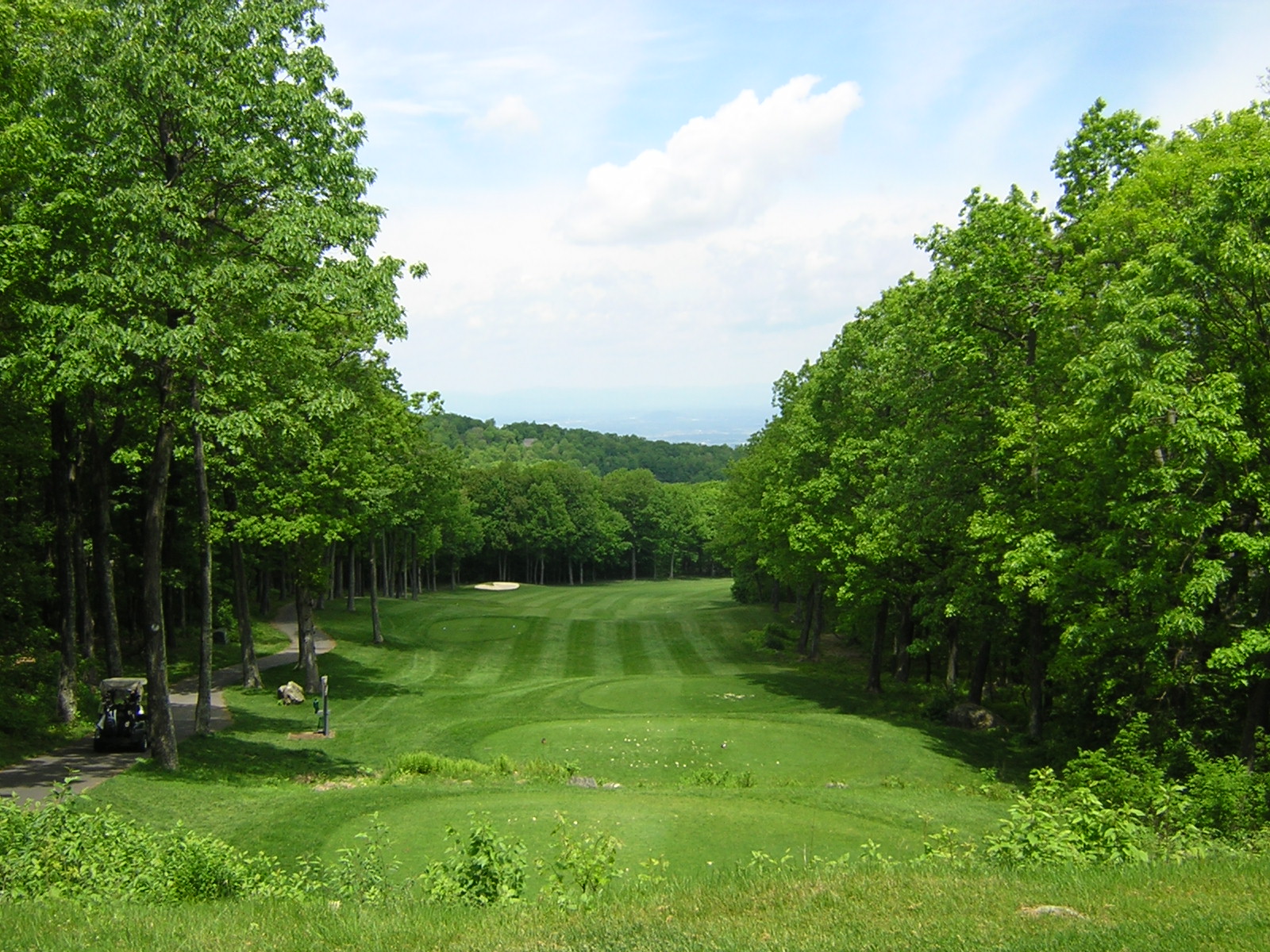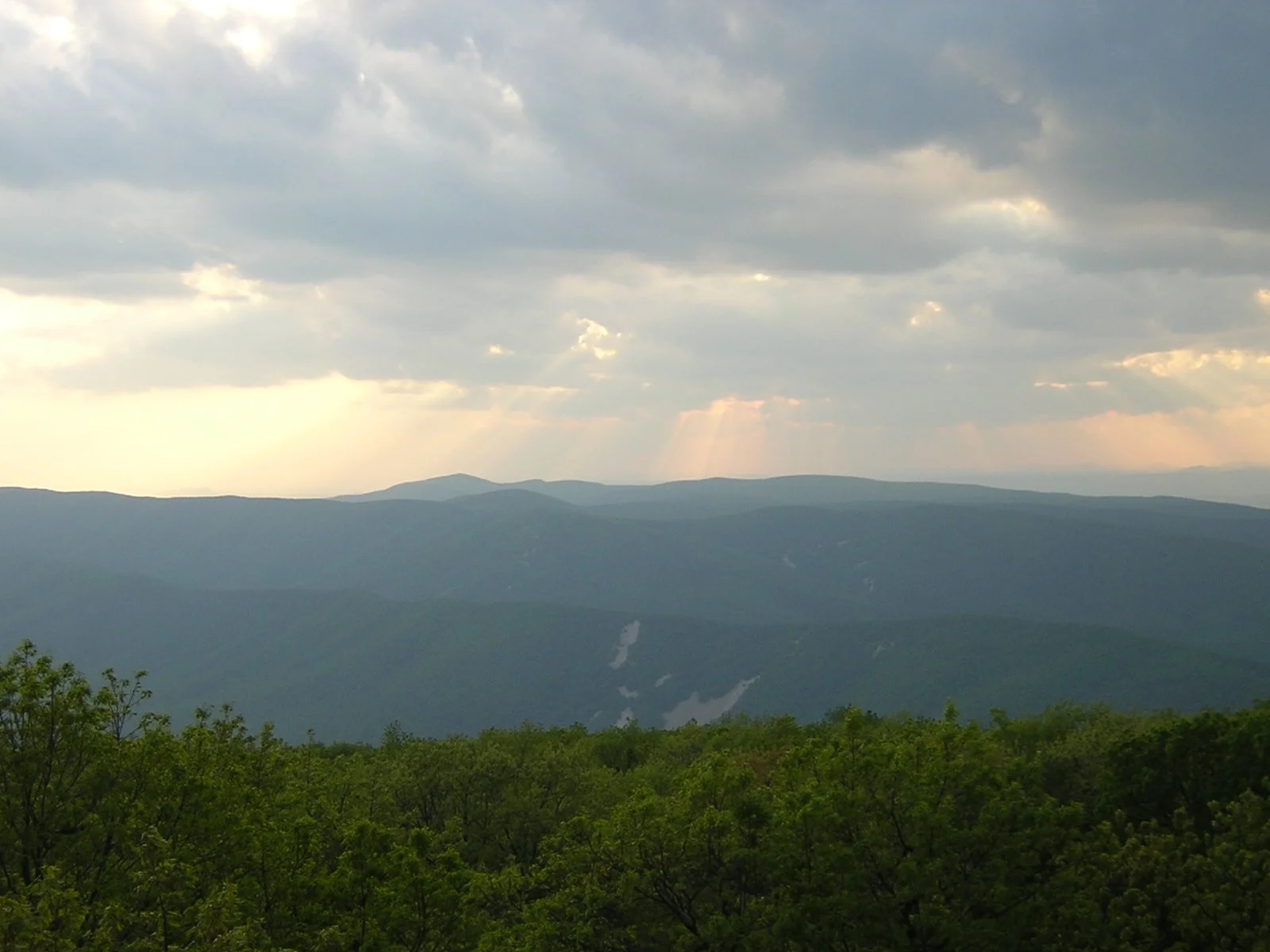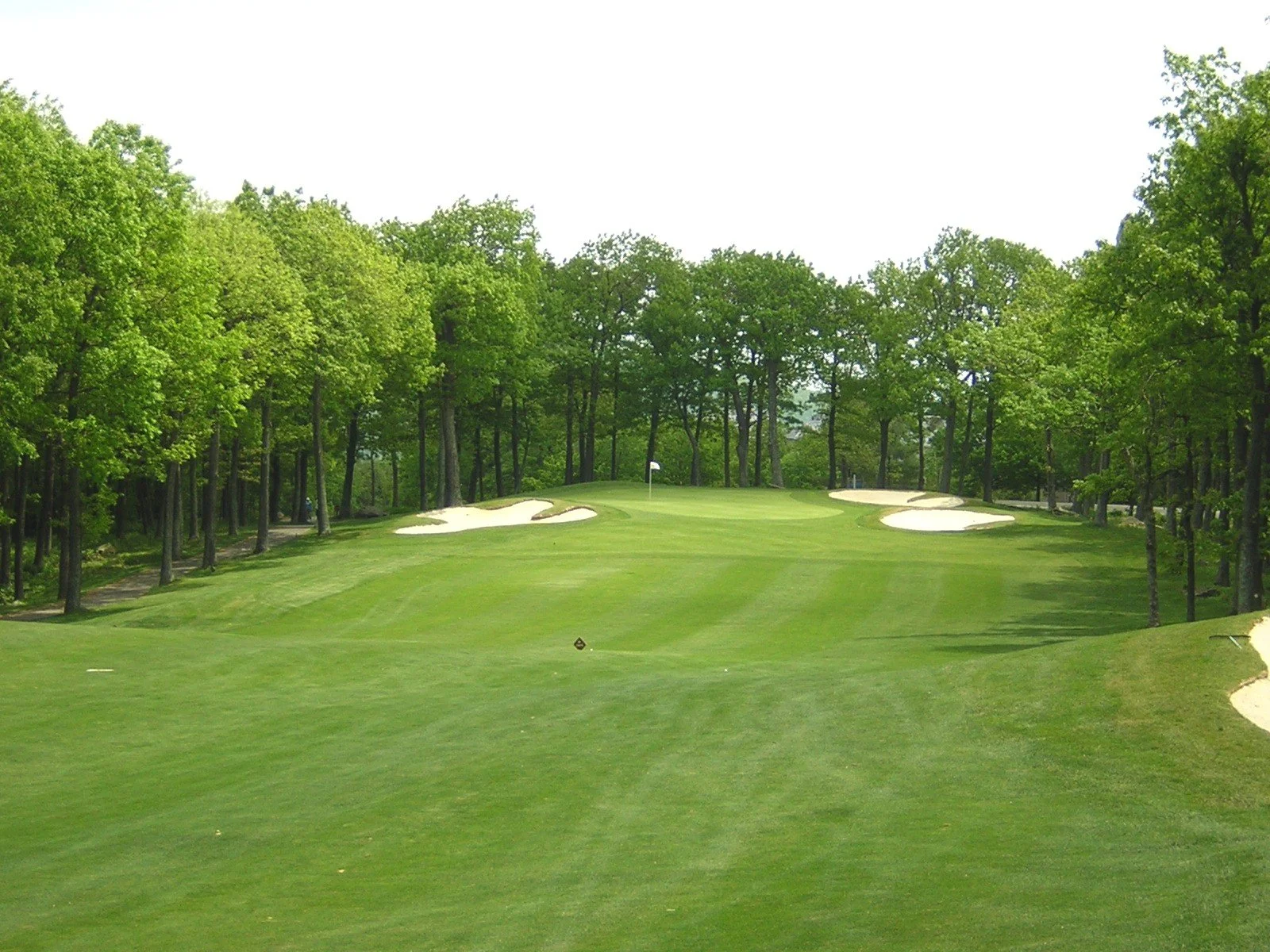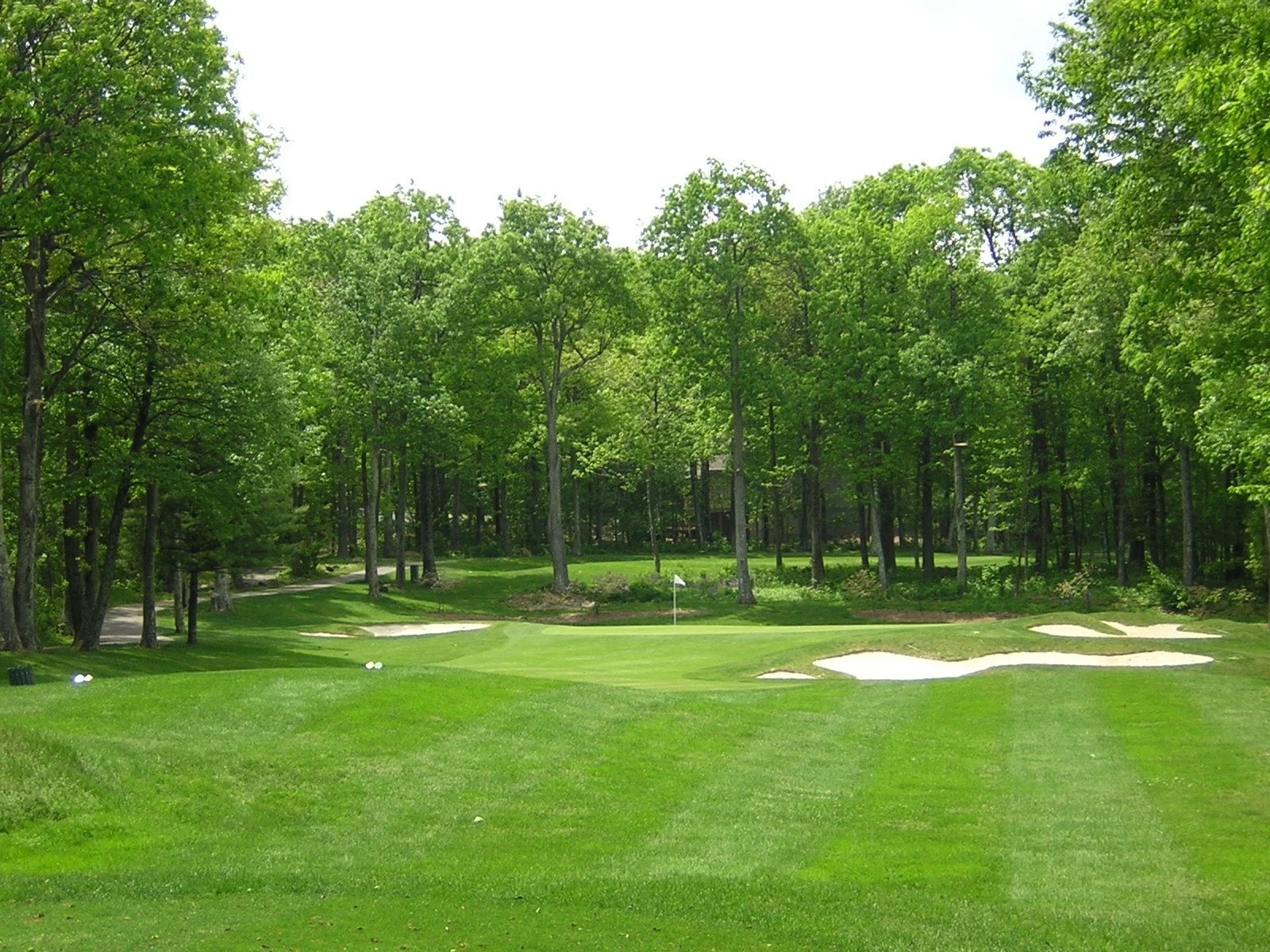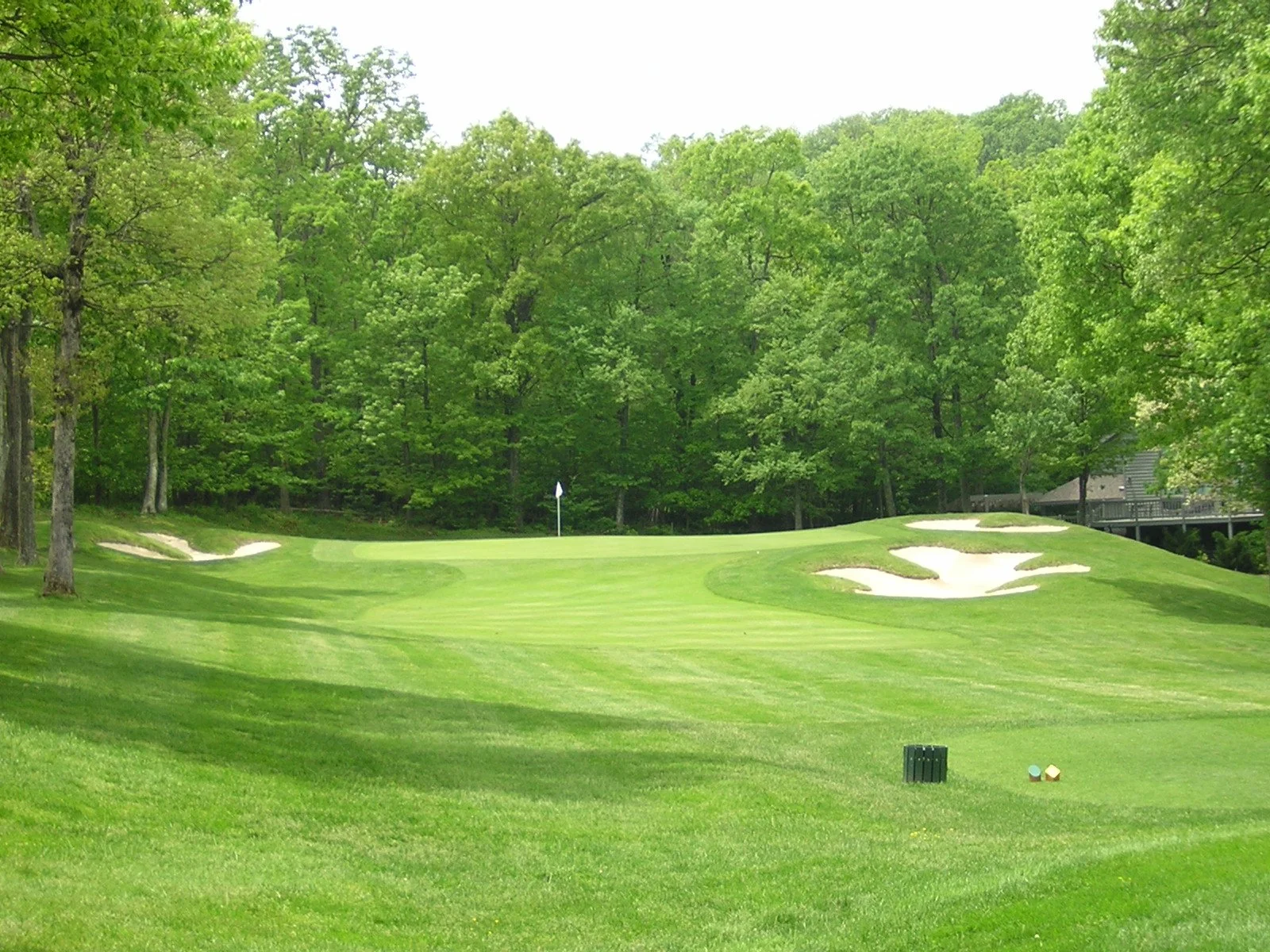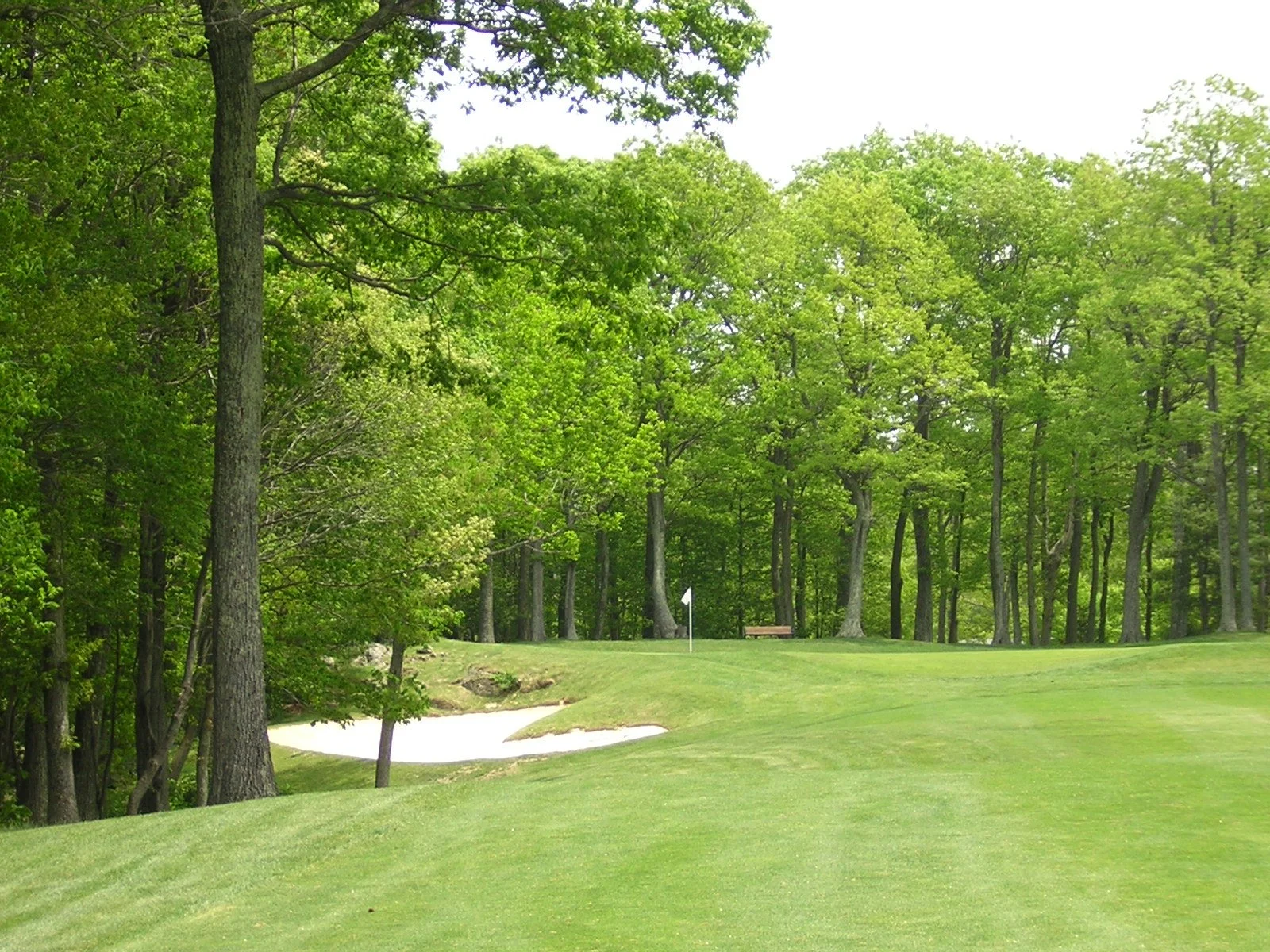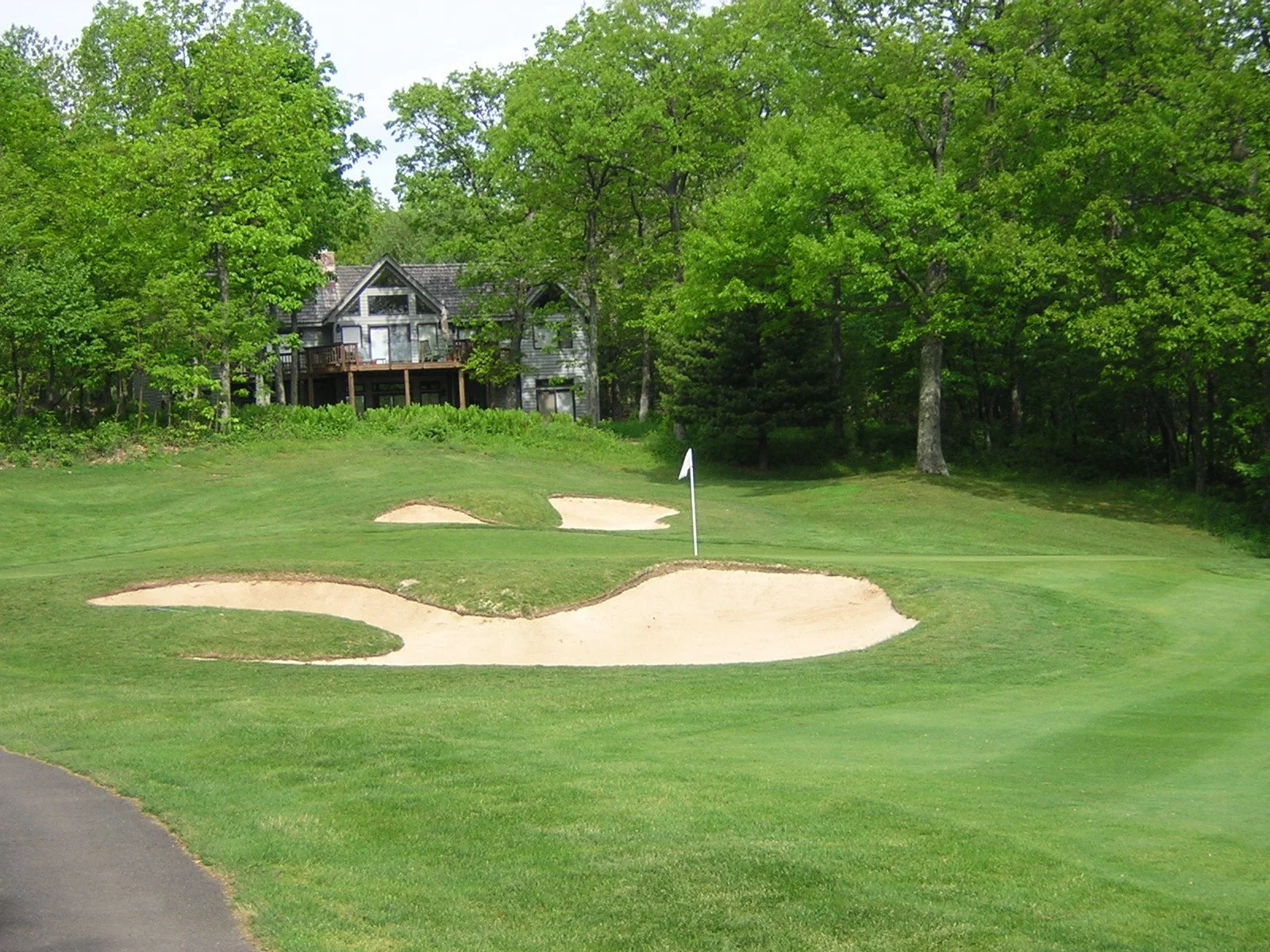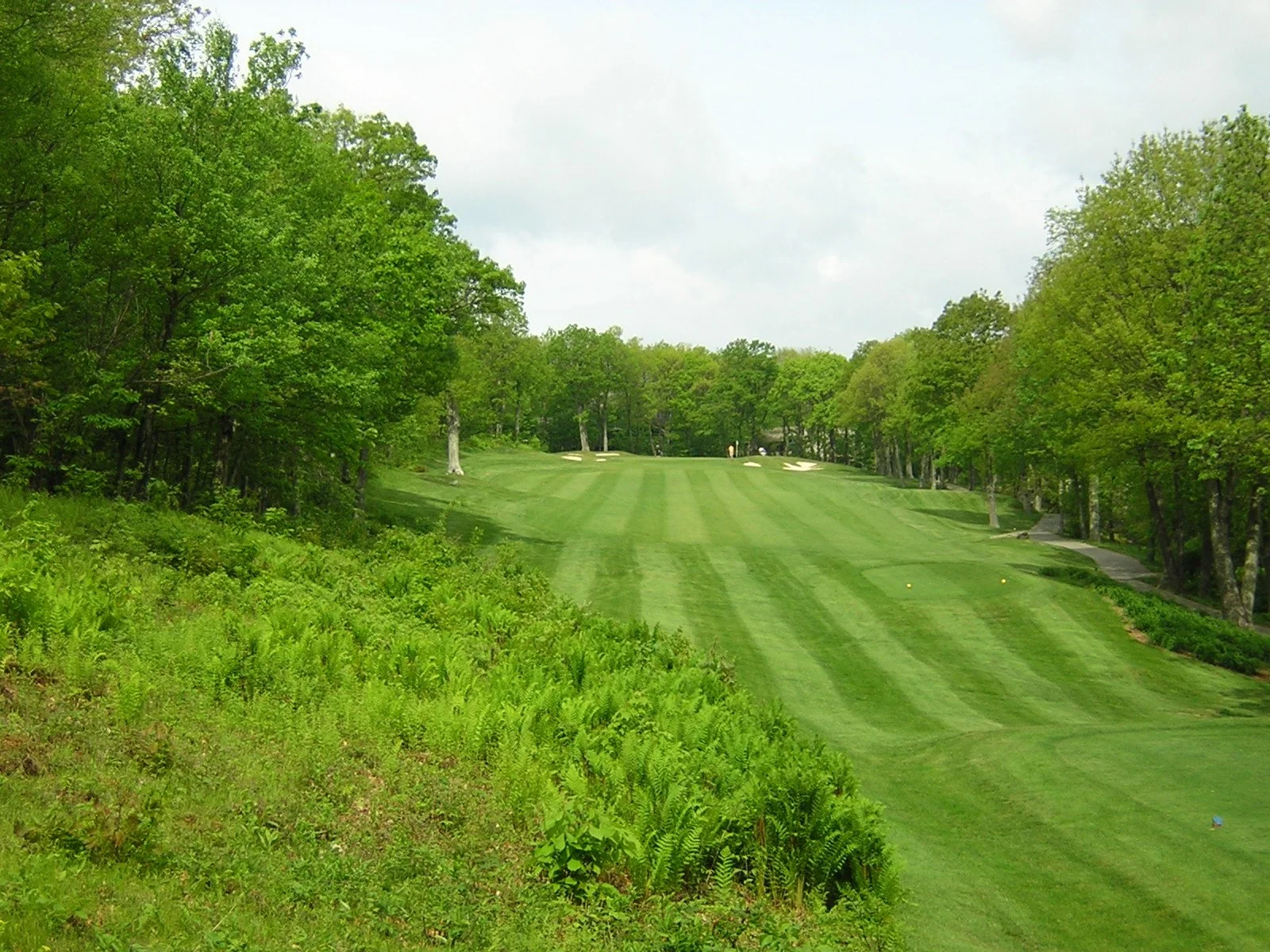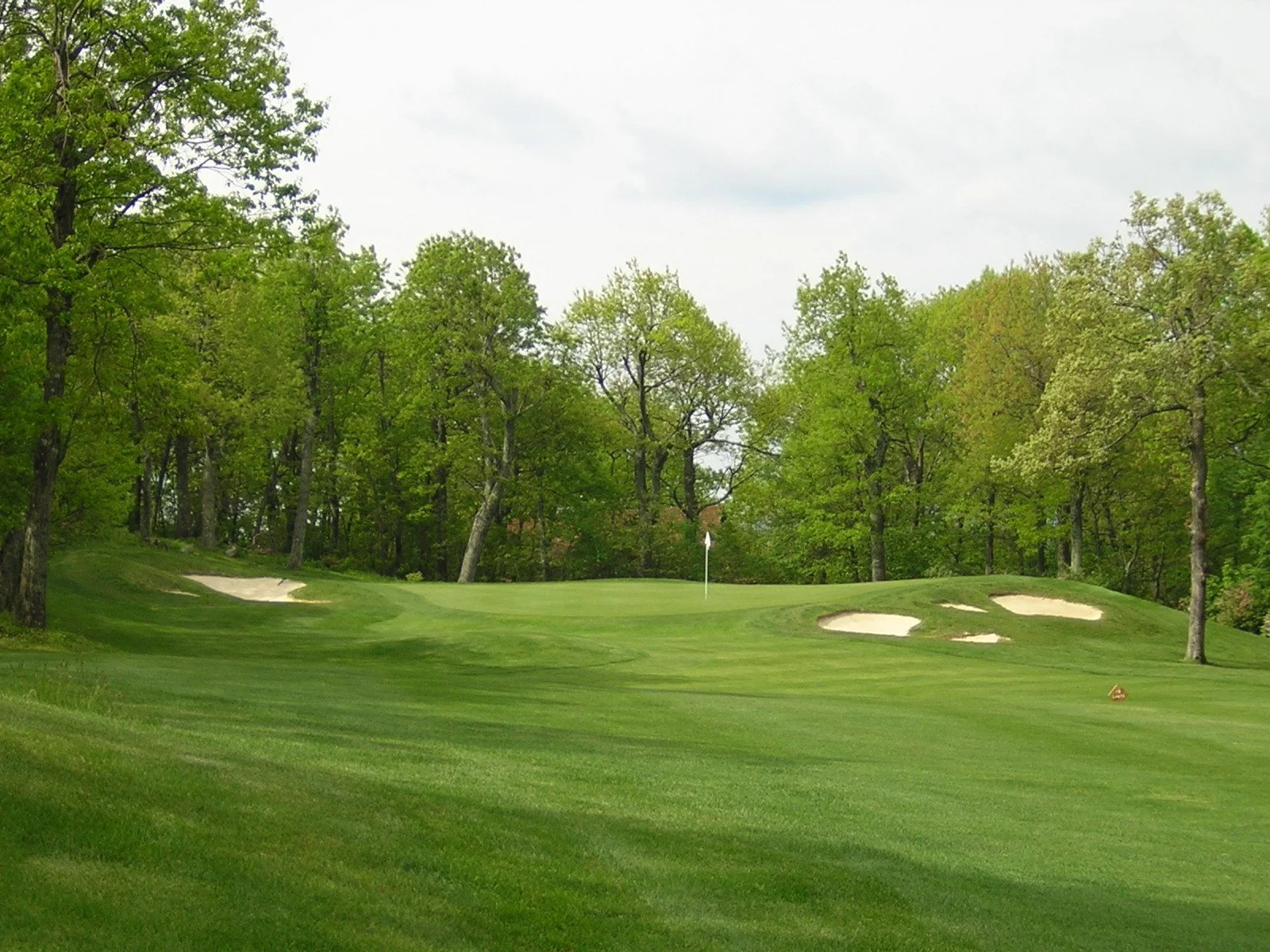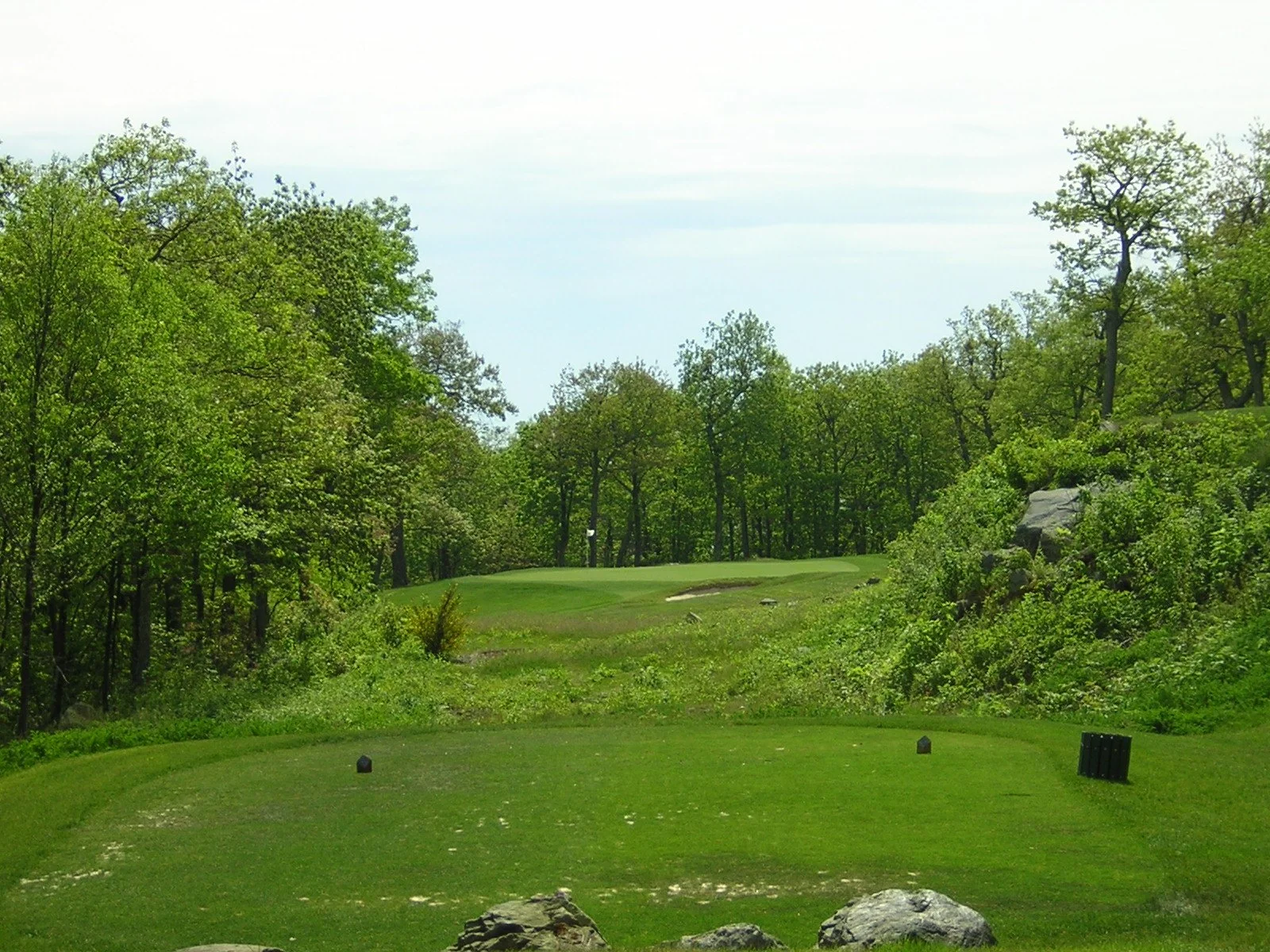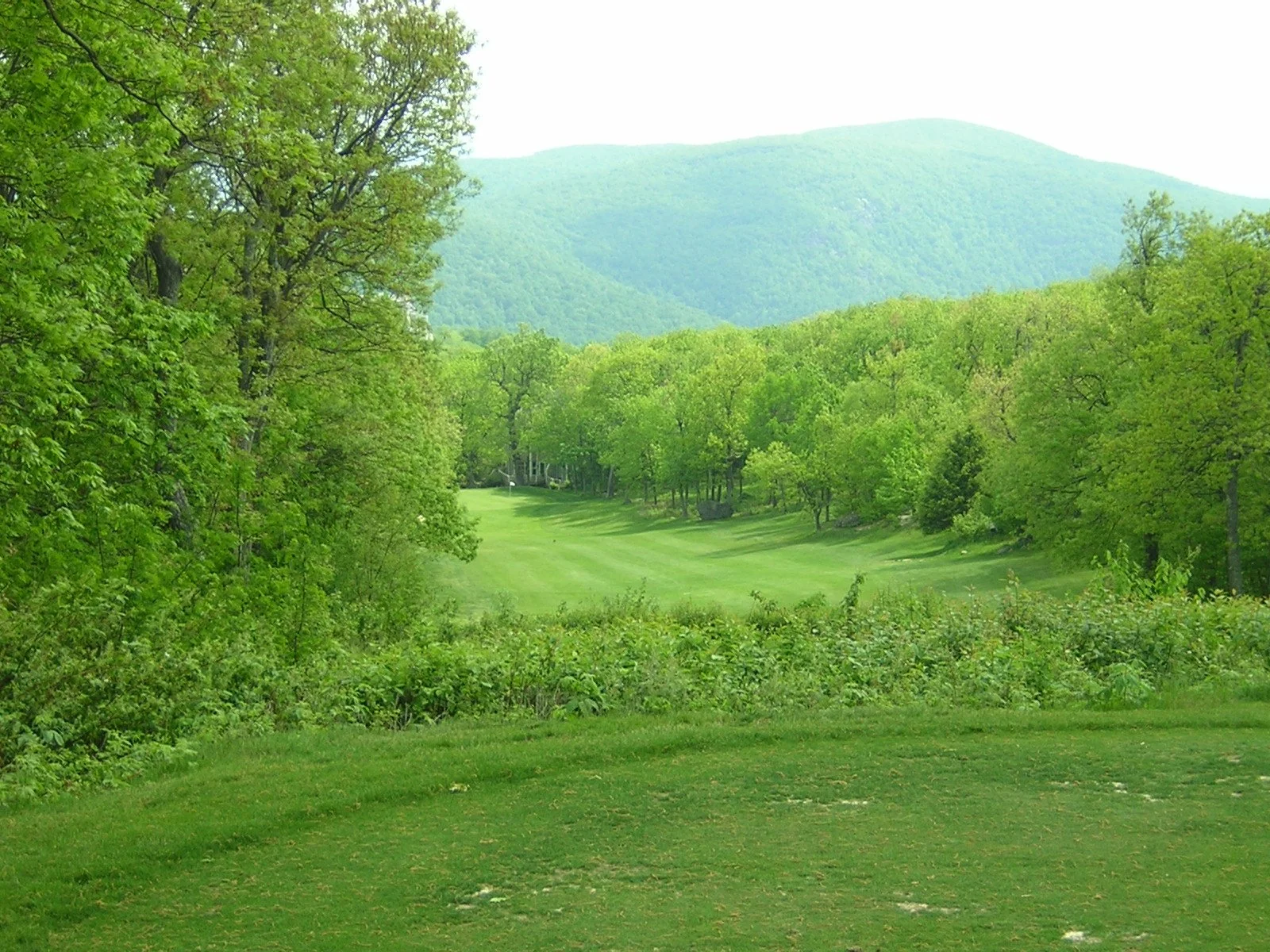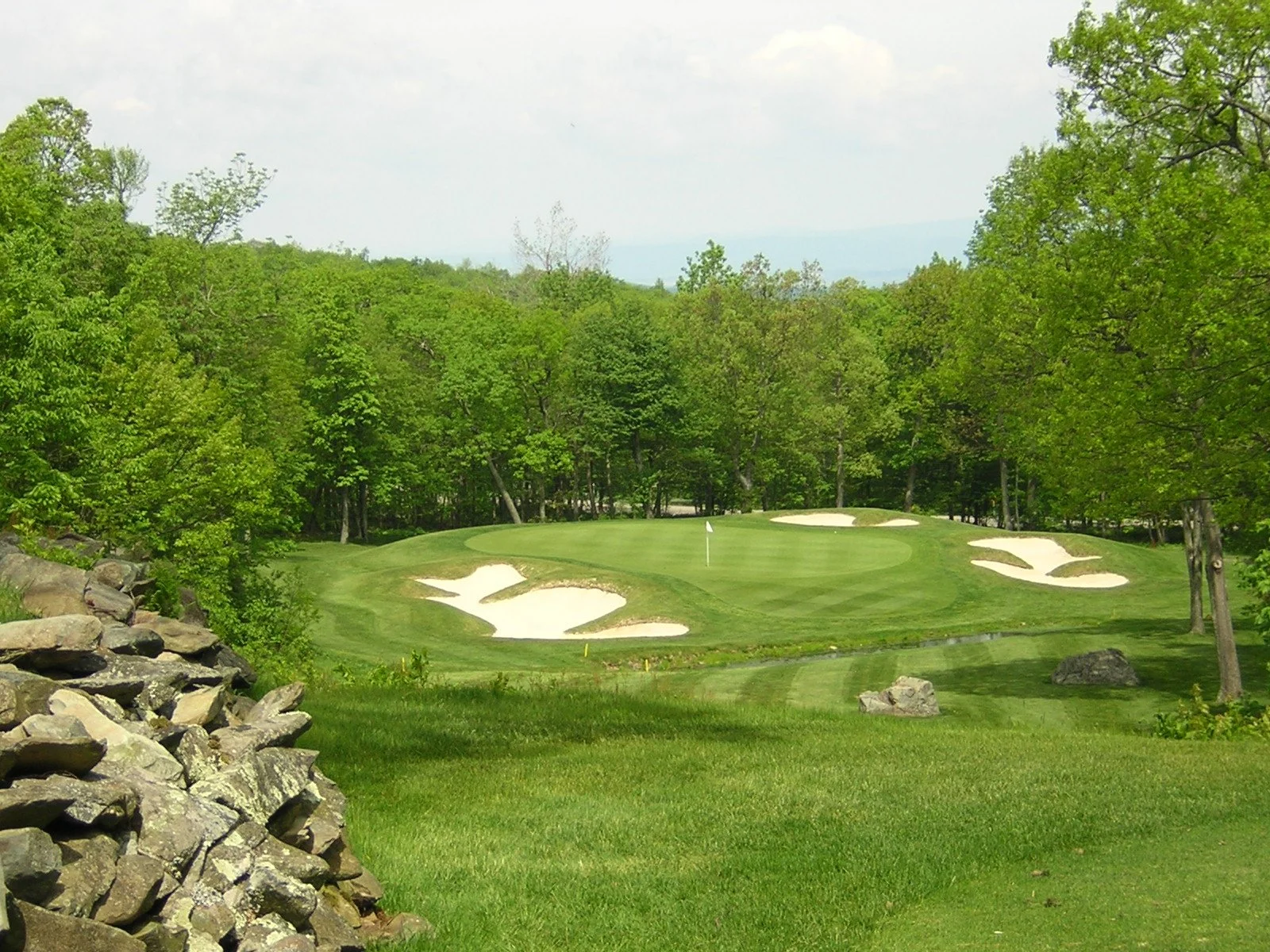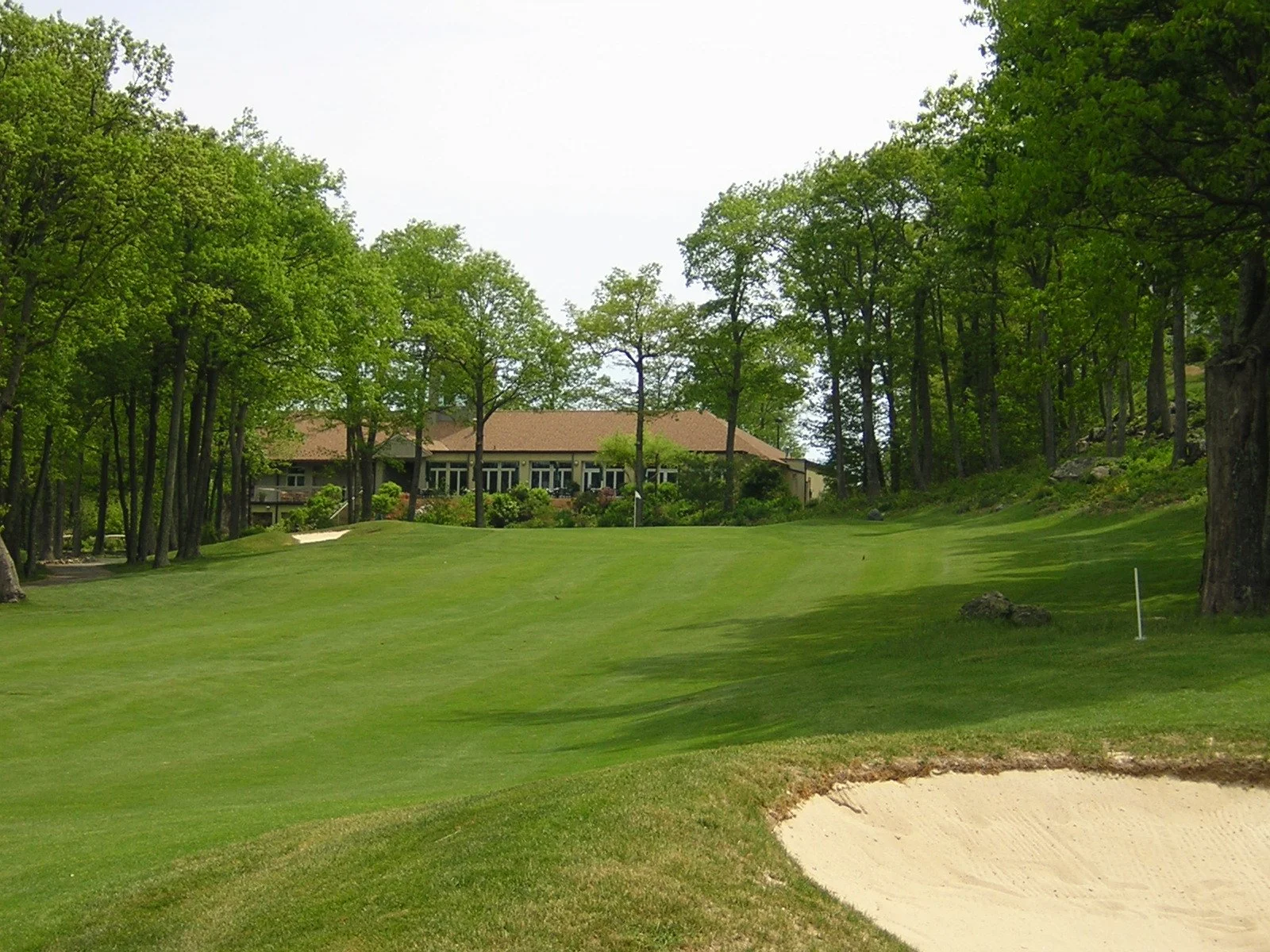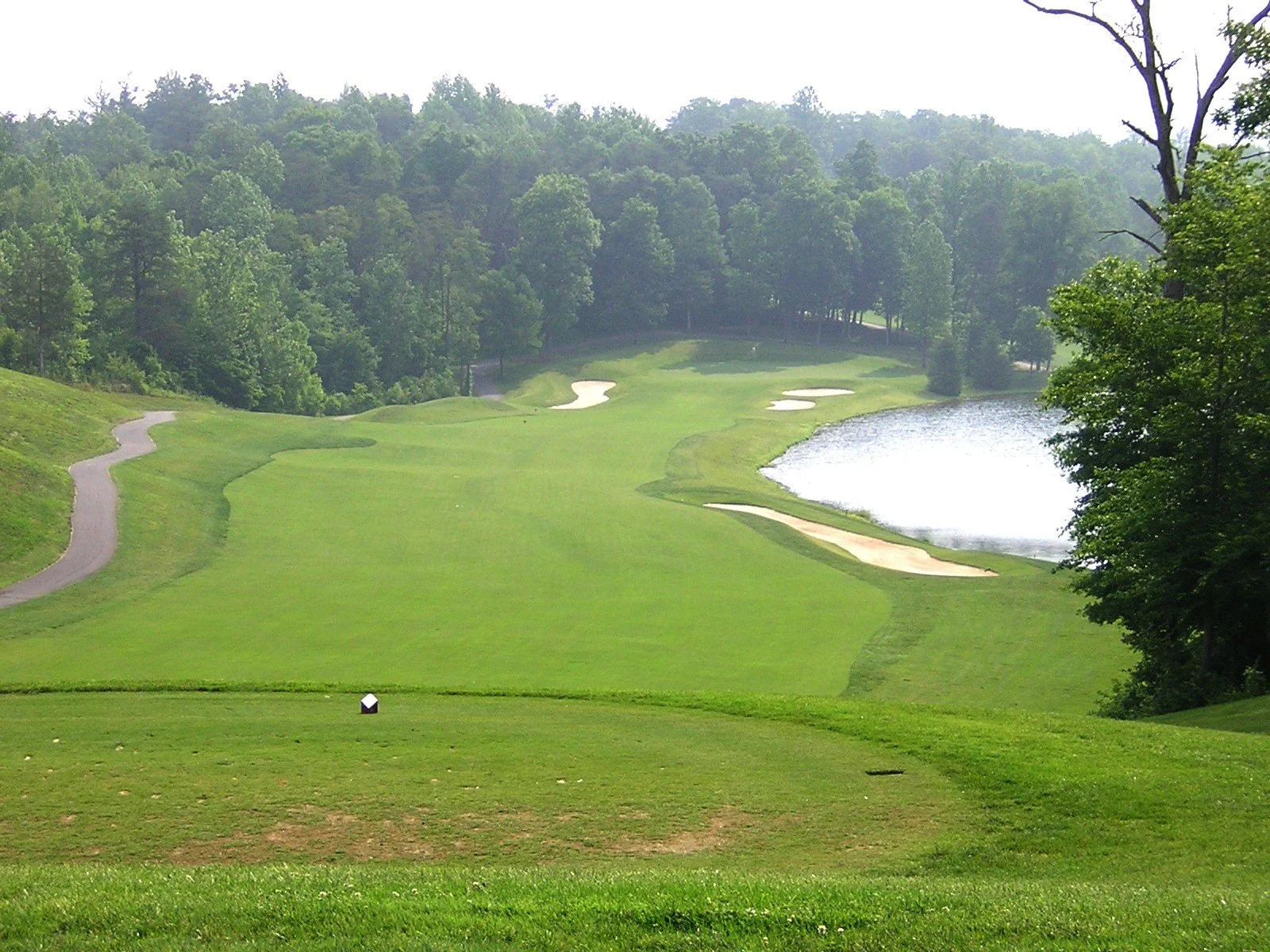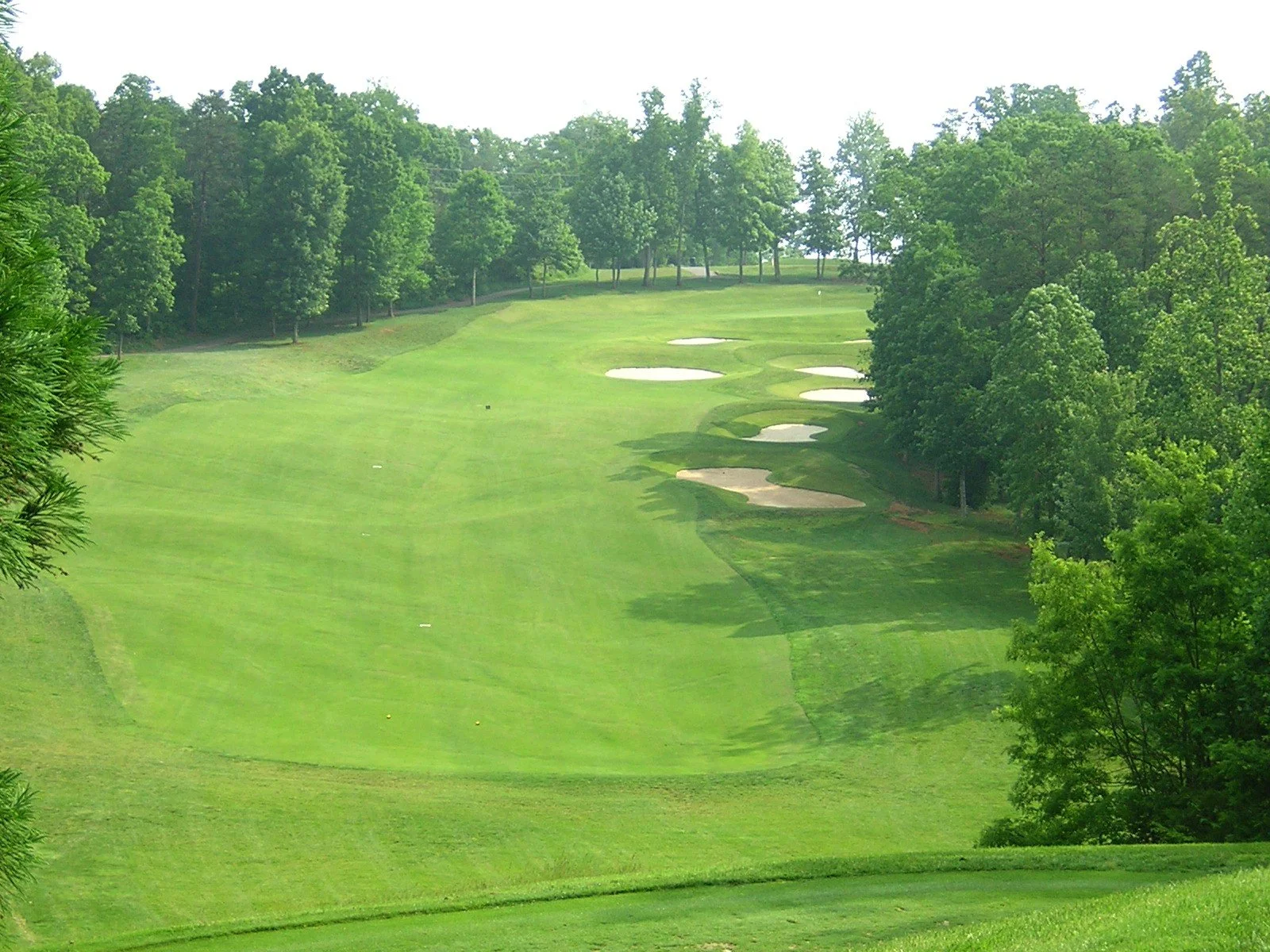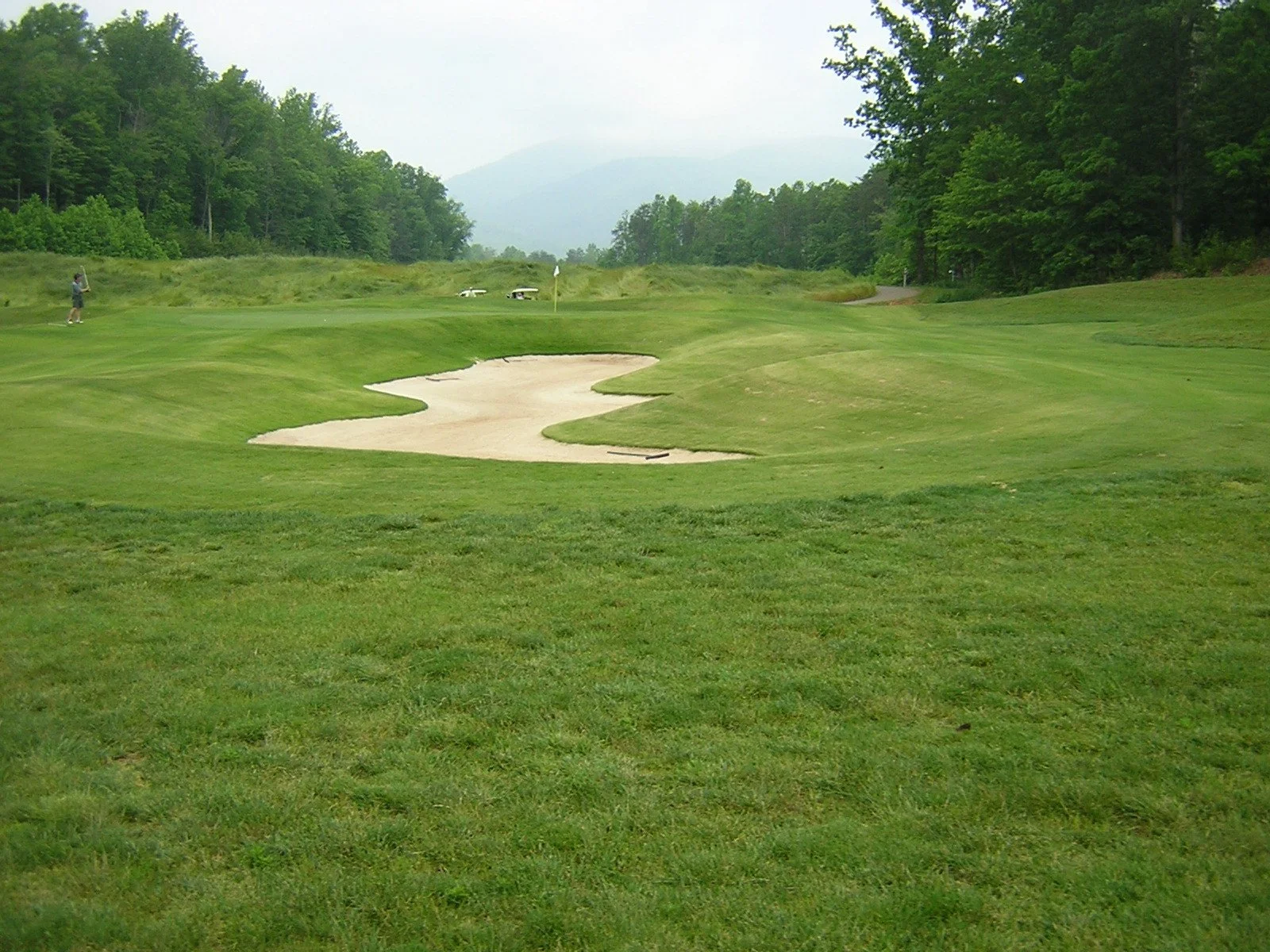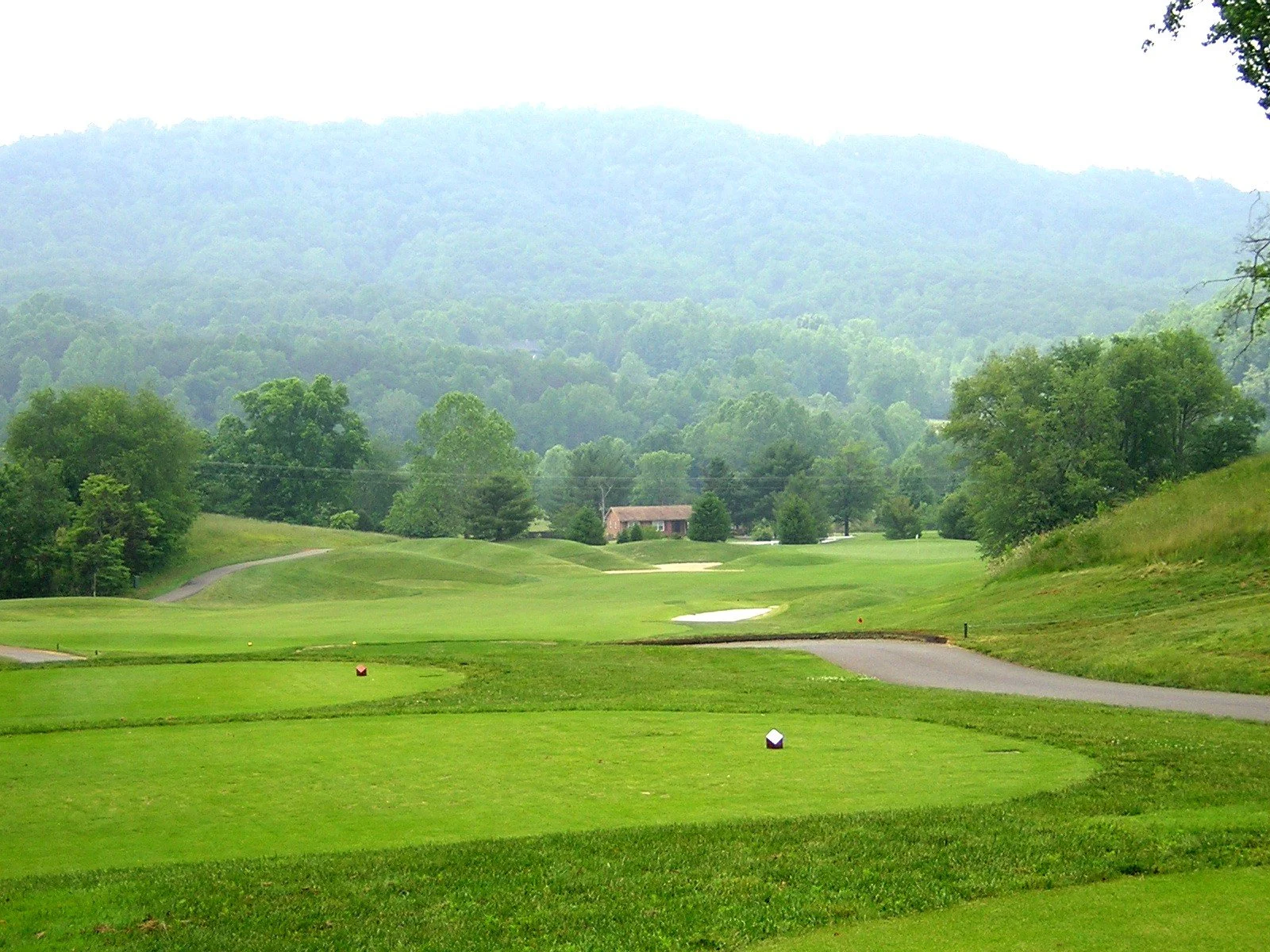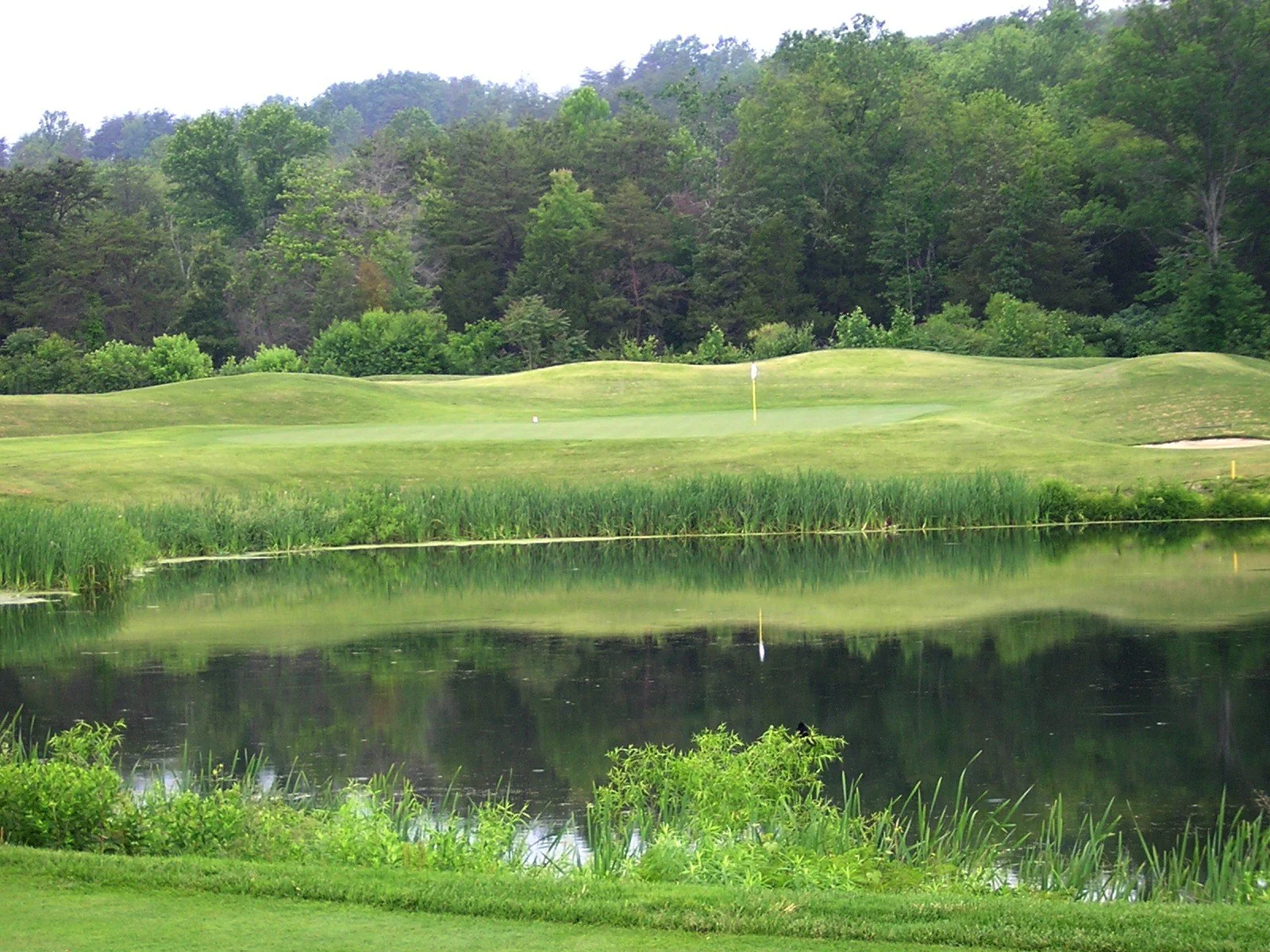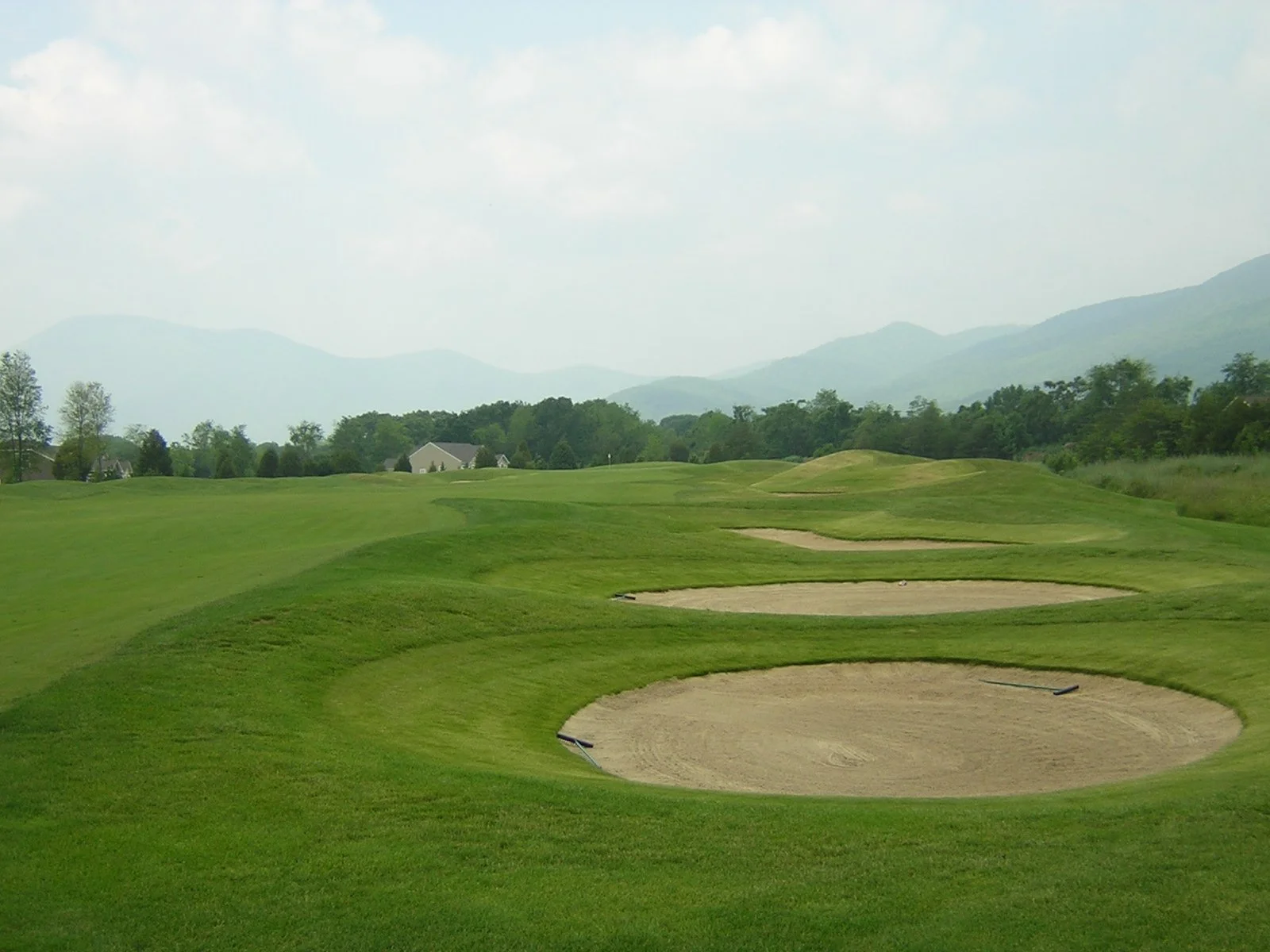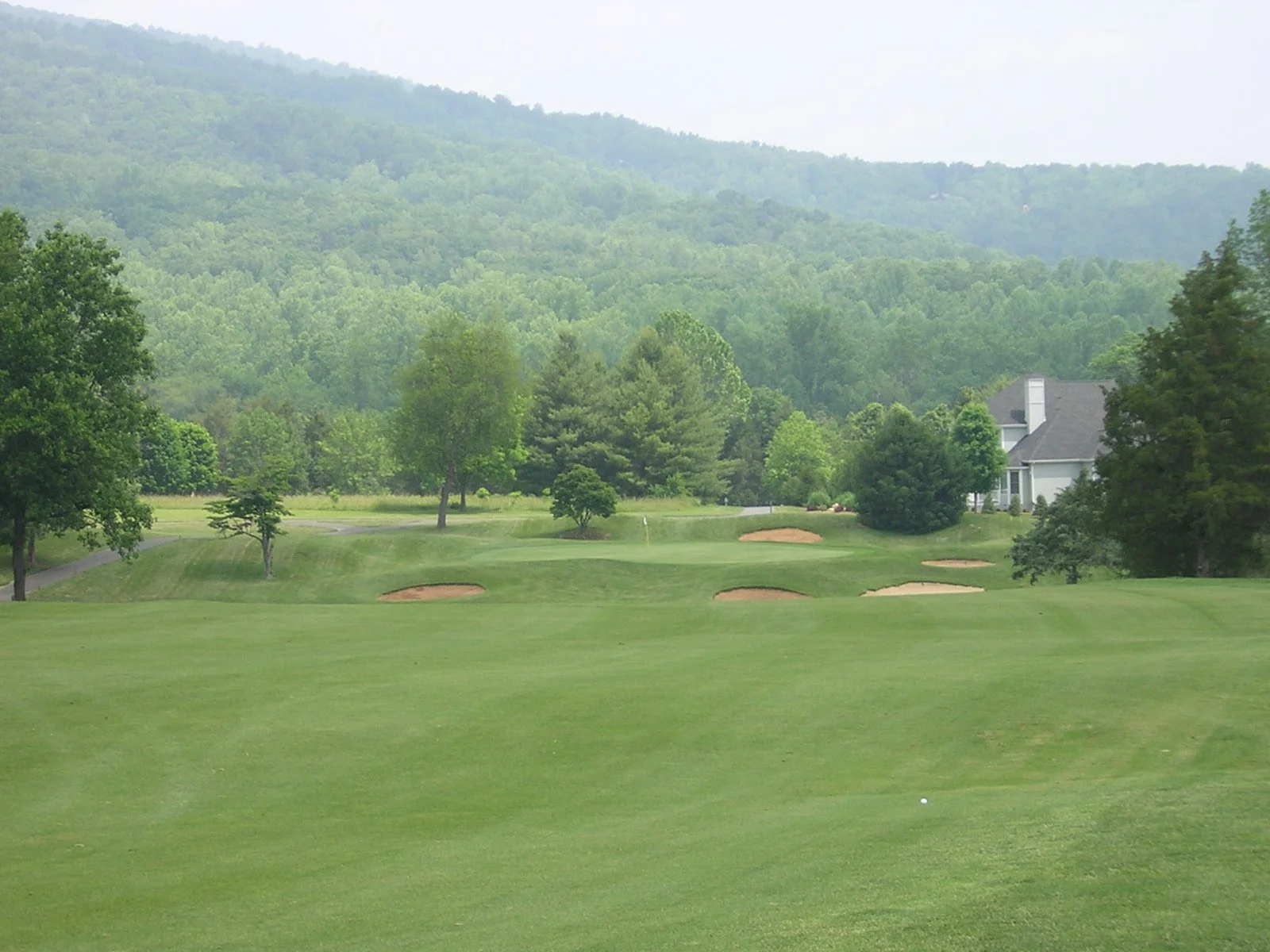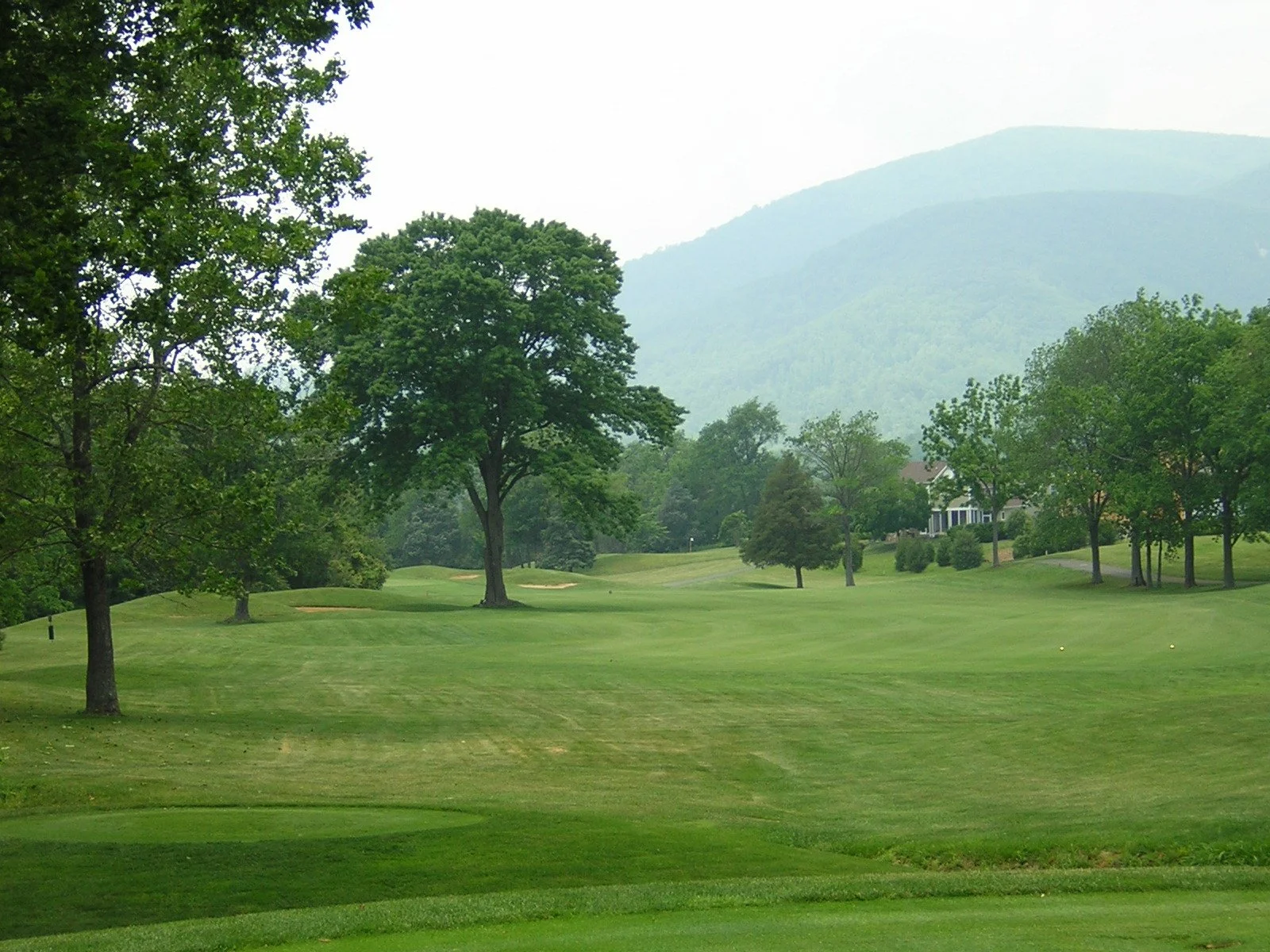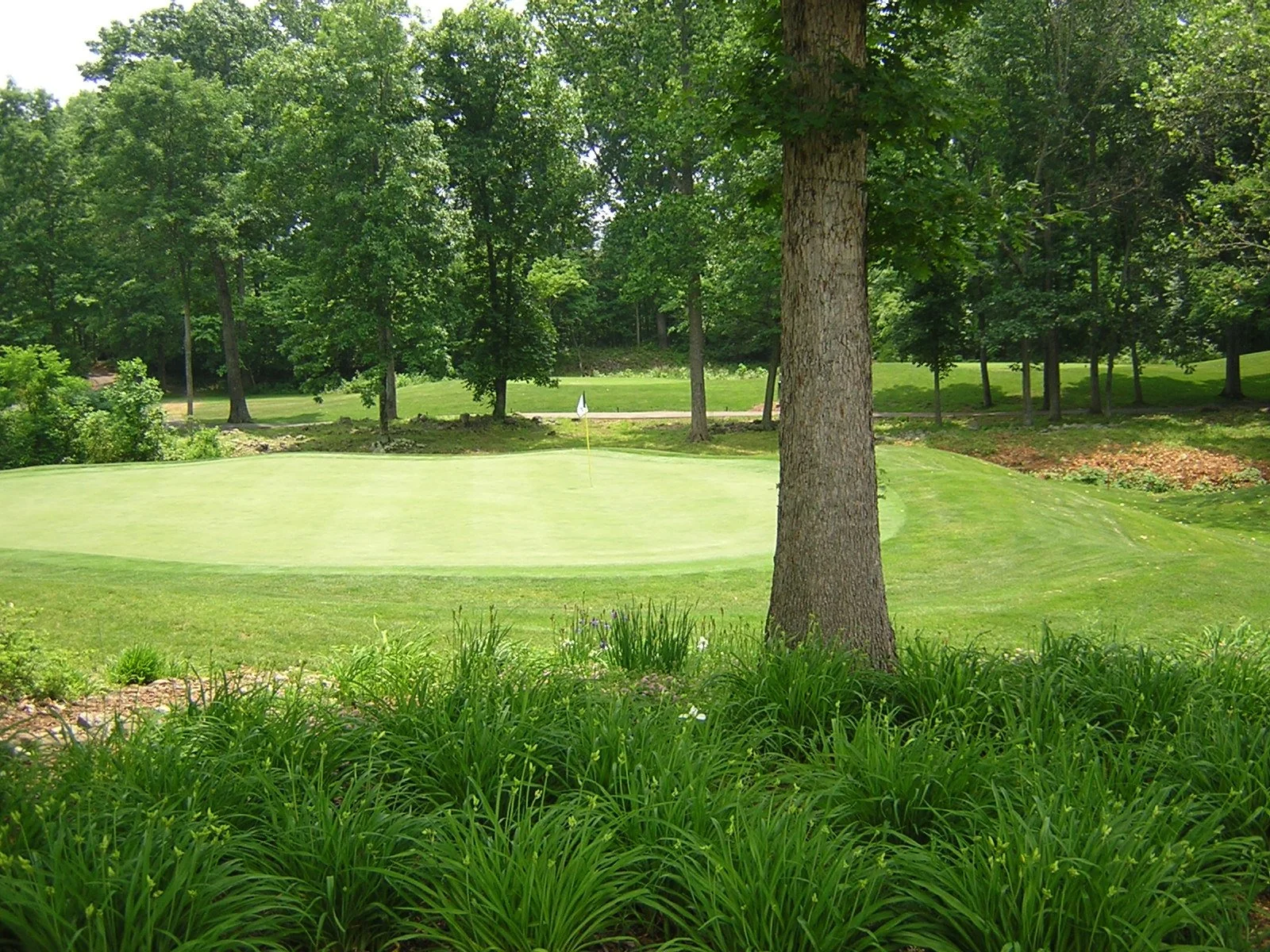WINTERGREEN RESORT (DEVILS KNOB/STONEY CREEK)
Devils Knob Architects: Ellis Maples/Dan Maples (1976), John LaFoy (Renovation, 2003-04).
Year Opened: June, 1976
Location: Wintergreen, Virginia
Slope: 138. Rating: 72.2
Par: 70
Yardage: 6,712
Hole-by-Hole: 1 - Par 4 411 Yds 10 - Par 5 571 Yds
2 - Par 4 392 Yds 11 - Par 4 392 Yds
3 - Par 4 520 Yds 12 - Par 4 354 Yds
4 - Par 3 160 Yds 13 - Par 4 370 Yds
5 - Par 5 487 Yds 14 - Par 4 374 Yds
6 - Par 3 194 Yds 15 - Par 3 185 Yds
7 - Par 5 585 Yds 16 - Par 4 417 Yds
8 - Par 3 200 Yds 17 - Par 3 185 Yds
9 - Par 4 485 Yds 18 - Par 4 430 Yds
Par 35 3,434 Yds Par 35 3,278 Yds
Key Events Held: Virginia State Amateur,
Virginia State Mid-Amateur,
Virginia State Junior Amateur.
Awards Won: Best Golf Resort (Platinum) - Blue Ridge Country Magazine (2013),
Must-Play Courses by GolfStyles Washington (2009),
Rated four stars by Golf Digest - Best Places to Play,
Silver Medal Resort by Golf Magazine (1996).
Stoney Creek Architect: Rees Jones (1988 - Original 18, 1998 - Tuckahoe nine),
Wintergreen Staff (Restoration/redesign - Tuckahoe, 2007-08)
Year Opened: May 31, 1988
Location: Wintergreen, Virginia
Slope: Monocan/Shamokin 132, Tuckahoe/Monocan 136, Tuckahoe/Shamokin 137
Rating: Monocan/Shamokin 74.0, Tuckahoe/Monocan 73.8, Tuckahoe/Shamokin 74.2
Par: 72
Yardages: Monocan/Sham (7,015), Tuckahoe/Mon (7,081), Tuck/Shamokin (7,158)
MONOCAN SHAMOKIN TUCKAHOE
Hole-by-Hole: 1 - Par 5 570 Yds 1 - Par 4 442 Yds 1 - Par 4 473 Yds
2 - Par 4 370 Yds 2 - Par 4 396 Yds 2 - Par 4 354 Yds
3 - Par 4 446 Yds 3 - Par 3 181 Yds 3 - Par 5 564 Yds
4 - Par 4 420 Yds 4 - Par 5 578 Yds 4 - Par 3 226 Yds
5 - Par 3 171 Yds 5 - Par 4 355 Yds 5 - Par 4 505 Yds
6 - Par 4 373 Yds 6 - Par 4 416 Yds 6 - Par 4 350 Yds
7 - Par 4 414 Yds 7 - Par 3 202 Yds 7 - Par 4 391 Yds
8 - Par 3 180 Yds 8 - Par 5 516 Yds 8 - Par 3 165 Yds
9 - Par 5 525 Yds 9 - Par 4 460 Yds 9 - Par 5 584 Yds
Par 36 3,469 Yds Par 36 3,546 Yds Par 36 3,612 Yds
Key Events Held: Lewis Chitengwa Memorial Championship (2003-04),
Virginia State Junior Amateur Championship (2006),
Virginia Women Team Matches (2008),
Virginia Mid-Amateur Championships (2008),
Women's Eastern Amateur Championship (2009),
VSGA Amateur Championship Qualifier (2011).
Awards Won: Rated four stars by Golf Digest - Best Places to Play.
Named runner-up for Best New Resort Courses - Golf Digest (1990).
Awarded Best Golf Courses in the Mid Atlantic - Washington Post.
Ranked #9 - Best Course Near You by Golf Magazine (2008).
Web site: www.wintergreenresort.com
HISTORY: Back in the late 1960s, a group of investors purchased a 10,000-acre parcel of land in the heart of the Blue Ridge Mountains. "The Big Survey," as it was known, was home to spectacular wildlife and rugged, wooded terrain.
One of Boston's oldest and venerable real-estate firms, Cabot, Cabot & Forbes, purchased the property, and due to its efforts along with those of The Sea Pines Company, Wintergreen Resort started to become a reality.
Eight ski slopes and several chair lifts were in operation by 1975, not to mention the resort's first restaurant, The Copper Mine. Just one year later, however, Melba Investors Inc. acquired the property and the Wintergreen Development Inc. was founded.
The first golf course, Devils Knob, was designed by Ellis Maples and his son, Dan in 1976, as they climbed and weaved their way through 1,000 acres of thick wooded hillsides to craft a layout so summer vacationers could venture to the resort. Maples and his design team were responsible for over 70 golf courses in the Southeast, including Pinehurst No. 5.
"We would come out of those woods up there at the end of the day, knowing we had walked the whole golf course," Dan Maples recalled. "We could almost find the whole golf course already up there on those old trails."
The younger Maples and his father crafted 17 courses together, but none tougher to design than Devils Knob, due to the severe elevation changes and the large rock formations throughout the property.
"It was pretty treacherous," Maples said. "But it worked out beautifully."
Tennis was not far behind, and in 1978 the mountain tennis center was completed.
By the end of 1980, the Mountain Inn and Conference Center was completed, as the resort became a year-round destination. The first Wintergarden Spa opened its doors in the fall of 1984, and in '85 former first lady Lady Bird Johnson dedicated the Wildflower Park in tribute to Wintergreen's preservation of native plants.
The first 18 holes at Stoney Creek, designed by the "Open Doctor," Rees Jones, opened in 1988. Jones, who has redesigned and restored many U.S. Open and PGA Tour stops, such as Torrey Pines, Congressional, Bellerive, Bethpage, Oakland Hills and Baltusrol, crafted the Monocan and Shamokin nines in and around Lake Monocan, featuring wonderful views of the Blue Ridge Mountains. The positive reviews began pouring in quite quickly. In fact, Golf Digest named Stoney Creek as one of the two "Best New Resort Courses in the Country."
Ten years later, Jones completed work on the Tuckahoe nine, and the Wintergarden Spa and Fitness Center re-opened following a complete renovation and expansion.
All three nines are named with the Native American legacy in mind. Monocan is the Algonquian word signifying a digging stick, or spade, possibly for those who worked the fruitful soil. The Shamokin name is linked to a meeting place for Virginia's Saponi and Tutelo nations, while Tuckahoe is the word of an abundant freshwater root that was roasted to provide a valuable food source.
Not one to rest on its laurels, the Devils Knob course started a two-year renovation project in 2003, as John LaFoy was brought in to rebuild 44 bunkers, as well as adding new forward tees. In addition, the installation of a computer-controlled irrigation system was completed. LaFoy, who worked closely with golf course architect George Cobb in remodeling of Augusta National, has designed and renovated over 100 courses in his career.
For two years, the Stoney Creek Course at Wintergreen hosted the Canadian Tour's Lewis Chitengwa Memorial Championship. Chitengwa, who hailed from Zimbabwe, attended the University of Virginia, where he had a very successful college career. In fact, Chitengwa defeated Tiger Woods by three shots to win the 1992 Orange Bowl World Junior Tournament in Miami. In 1993, Chitengwa became the first black golfer to win the South African Amateur Championship. Chitengwa died suddenly at the age of 26 prior to the third round of the
Canadian Tour's Edmonton Open due to meningococcemia, a strain of meningitis.
In 2003, current PGA Tour player Nick Watney posted a five-shot win over three players to record his first Tour win of any kind, just after turning professional earlier in the year. Playing on a sponsor's exemption, Watney blitzed the Monocan and Shamokin layout with rounds of 66-67-68-67 in just his fifth event after turning pro. Alan McLean, one of a trio of second-place finishers, shot a course-record 64 in the final round.
Stephen Gangluff recorded a four-shot win in 2004 when he defeated five players with a 13-under-par score. Gangluff trailed by five shots after the first round, but shot rounds of 66-68-69 to cruise to the victory, his first on the Canadian Tour in his first-ever start on that circuit. What was even more special for Gangluff was that he played a practice round with Chitengwa just a few days before his death. "It means the world to me to be a champion here," Gangluff said. "Lewis was such a great man and a great talent."
Just a few years later in 2007-08, the Resort continued to upgrade the golf courses, as renovation changes were made to the Tuckahoe nine at Stoney Creek.
The lush turfgrass called Cavalier Zoysia was installed in every fairway on the Tuckahoe layout. "Day in and day out, these are the best surfaces to play on," said Geoff Redgrave, director of golf at Wintergreen, "and personally, I think our fairways are the best on the East Coast."
Stoney Creek was the first course in the region to install the new grass, which replaced the combination of Bentgrass and Fescue. Six holes received new tee boxes, adding more than 300 yards to the course, including Virginia's first par four of 500 yards.
In addition, the Tuckahoe nine also was given a junior upgrade, as a complete new set of juniors-only tees were made on each hole. Finally, all nine greens were restored to Jones' original specifications.
"Each of the nines present a different flair and a different look to them," continued Redgrave. "Monocan is kind of the open nine of the three, as it winds itself around and is fairly flat with a signature par-3 over water. Shamokan is what we call the original back nine. It winds you around with six doglegs and very little in the way of homes with some elevation change to it. It's a nice
little mix of wooded holes, with doglegs and elevation, such as the par-3 seventh, that plays 60 feet down the hill to the green. Finally, the Tuckahoe nine is a lot of up and down with plenty of topography change and water, including the par-3 eighth over a pond."
In 2009, Isabelle Lendl captured the WEGA Amateur Championship, as she defeated Brittany Altomare and Kristina Wong by four shots. Lendl, the daughter of tennis great Ivan Lendl, opened the 98th Women's Eastern with a course-record 67.
A second-round 75 had her trailing Wong by two shots heading into the final round. Wong increased her lead to three after a birdie on 10. However, Lendl made back-to-back birdies on 12 and 13, while Wong made bogey on 12 and then dumped her tee shot into the water on 14. Her final round of 70, including a back nine of 33 was easily enough to defeat the runner-ups. Lendl was the only player in the field to break par in two of the three rounds.
In 2012, coal tycoon James C. Justice, owner of the historic Greenbrier Resort, purchased Wintergreen for an estimated $16.5 million, as the resort had filed for bankruptcy.
"We are excited about this acquisition for two reasons, one being the obvious tie in with our other properties, The Greenbrier Resort and The Resort at Glade Springs, the other being what this means for the property owners and members of Wintergreen along with the general public," Justice said. "We intend to take this property to the next level and see tremendous opportunities as we work
with the Wintergreen management and staff in developing new membership programs and vacation packages. The Wintergreen facilities are spectacular and the entire Resort has a tremendous impact on the local and regional tourism industry."
Interestingly enough, Wintergreen was one of the last places Justice played golf with his father before he had passed. So not only was this a wonderful investment, it has plenty of sentimental value.
Now, just two years later, the resort has been thriving in all facets, as Justice and his team have taken the resort "to the next level."
As recent as 2013, Wintergreen has been rated the No. 1 resort by Tennis Magazine for families and one of the Top American Tennis Resorts & Destinations in the United States by many publications.
In 2015, Wintergreen Resort was purchased by a real estate investment trust, EPR Properties. Resort General Manager, Hank Thiess believes this recent acquisition, can continue to push Wintergreen to the top."I've been in this industry for over 30 years and I've known the leadership of Pacific Group
Resorts for over 20 years. They have tons of experience in this industry at some of the most iconic resorts in the West. My management team and I are excited for the possibilities this partnership could bring to our members and guests."
REVIEW: DEVILS KNOB COURSE - At first blush, the Devils Knob course seems to be a pushover at 6,712 yards from the back markers. Don't be fooled. This is a par-70 layout with more twists and turns than The Big Bad Wolf at Busch Gardens with a slope rating of 138.
The opening hole is a dogleg right par-4 of medium length that sweeps downhill from the fairway. The key is a tee shot that must stay clear of the sloping mounds to the left of the landing area, as all balls are kicked into the trees. The approach to the green is fairly open, but gaping bunkers around the putting surface await.
Another medium-length par-4, the second hole bends to the left, and once again accuracy is key off the tee, as two long traps guard both sides of the landing area. Just a short-iron should remain to a back-to-front sloping green with three large bunkers, two right and one left protecting the short grass. At 28-paces deep, the green is one of seven on the opening nine measuring less than 30 yards in length.
The third is one of the most difficult holes on the course. From an elevated tee, the hole swings hard from left to right with thick trees running down both sides of the fairway. This is the longest par-4 at Devils Knob and it requires accuracy, not length. A well-placed tee ball will leave just a short-iron to a slightly elevated green. The putting surface is small and runs from back to front.
The first par-3 -- No. 4 -- is a short, slightly uphill beauty, just 160 yards in length and surrounded by tall, majestic trees. Take enough club and you should have little trouble, as long as you play from the right level. The two-tiered green can be tricky, especially if you're above the hole.
You'll be tempted to go for the green in two on the par-5 fifth hole. Just 487 yards from back markers, the hole plays slightly uphill from tee to green, and once again accuracy is key off the tee. Trees line both sides of the bunkerless fairway. Some sort of hybrid or fairway metal will be required to reach the promised land, which is fronted by deep bunkers. The kidney-shaped
green runs hard to the front and just 26 yards deep. A short-left play with your approach will leave just a little pitch to the green, thus setting up a real solid birdie attempt.
The longest par-3 on the course, the sixth is 194 yards long and plays every bit of the yardage. The green features three defined sections and is quite long. Sand left and right must be avoided at all costs if you wish to make par. Any tee shot long will roll off the back and any approach short will
slip back off the green.
Not many, if any, can reach the par-5 seventh in two. At 585 yards, it's by far the longest hole at Devils Knob. You'll need a massive blast just to clear the pond and creep around the corner of the dogleg left. It's straight uphill to the landing area for your second, as the fairway pinches in at the 150-yard marker. Sand guards the right landing area and a creek runs down the entire left side of the hole. Your third to the putting surface, over a creek, will need to dissect a pair of greenside bunkers. The green itself is less complicated, but birdies are handed out easily.
One of the several signature holes at Devils Knob, the eighth is a magnificent par-3. Not long, but very diabolical with a fronting lake, sand deep and left and a slick, undulating putting surface. Put all this together and add a little breeze and you're faced with one heck of a hole. Good luck!
The closing hole on the outward nine is rated as the second-most difficult on the course. Now 485 yards in length, the ninth is a dogleg-right, uphill par-4. Not only must your tee shot find the fairway, but it must be long, as your second plays one or two clubs longer. Toss in a two-tiered, 30-yard-long putting surface and you'll be hard-pressed to make par. A back-left pin is next-to-impossible to make birdie, let alone get close to. Play for par and be happy.
The back nine begins with the last par-5 on the course, stretching 571 yards from the Highlands Tees. Playing downhill from the tee, this three-shotter bends toward the right and features an ample landing area. Where it gets tricky is the second shot, as a creek, 100 yards from the green, crosses the fairway. This could play havoc with your layup, but make sure you leave
yourself a full shot to the green because the putting surface is the tightest on the course at just 20 paces deep. The green is bunkered in front and rear and requires an extra club, as it sits well above the fairway.
No. 11 is a another sharp, dogleg-right par-4 that plays uphill from the fairway. At 392 yards, this hole is not to be taken lightly. Accuracy off the tee will certainly help your cause, as will hugging the right side of the fairway. A mid-iron will remain to an elevated green that's 28 yards in
length. Although the 11th is the only hole on the course without sand, a winding creek runs down the entire right side through the green.
At 354 yards, the 12th is the shortest par-4 on the course. Playing straightaway, this hole plays slightly uphill from tee to green. Fairway-metal or hybrid should be the club of choice, as trees line both sides of the landing area. The putting surface is quite large with sand on both sides. It's
one of the easier targets on the course.
The 13th is an uphill, dogleg-left par-4 just under 380 yards in length. Once again, the tee shot is key, as the fairway tightens in the landing area and rock formations on the left repel balls to the right. The putting surface is well-trapped on the left and right, making your approach shot all the more critical.
At the highest point on the golf course, the 14th features a panoramic view from behind the tee of the Blue Ridge Mountains. You'd be remiss if you didn't take the time to wander back and gaze at this natural beauty. OK, back to work. This dogleg-left par-4 requires another accurate tee ball. Thick trees guard the left and rock outcroppings cover the right at the landing area. Just a short-iron should remain to a very tiny putting surface, only 22 paces deep. The slope of the green is minimal, but its narrowness makes it difficult to hit.
The final four holes are tight and tough and will be difficult to negotiate at par, starting with the 15th, a solid par-3 of 185 yards. Carved into the forest, the green is quite wide and very shallow, requiring pinpoint accuracy. The putting surface falls off sharply left and deep, so any shot slightly offline will result in bogey or worse.
One of the prettiest holes, not to mention diabolical, the 16th is a sweeping, downhill par-4 which plays over 410 yards. From an elevated tee, you need to shape the ball from right to left to fit the fairway. This will leave just a short iron to a very small green guarded in the front-left by sand. A suggestion would be to leave the driver in the bag and use your fairway-metal off the tee. Birdies can be made from the fairway, bogeys from the trees.
The fifth and final par-3 on the course, the 17th is as good as it gets. Your thought process must comprehend three items when standing on the tee. It's 185 yards downhill -- one of the longest greens on the course -- and usually played into a stiff breeze. Now, if you have a club for that shot, then you're better than most. Let's toss in three deep bunkers surrounding the green and a creek to cross short of the surface. You get the picture. Good luck.
The final hole is a wicked, dogleg-right par-4, which plays longer than the yardage indicates. Although the fairway is manageable, the 20-yard bunker on the corner of the landing area must be avoided to have any shot at getting home in two. Even with a successful tee shot, you're faced with an uphill, medium-to-long-iron to another monster green, 34 paces long. What a finish!
STONEY CREEK COURSE - The opening hole on the Tuckahoe nine is a great, downhill par-4 stretching 473 yards from the tips. The key is the tee shot, as it must avoid the lake down the right side. The fairway is wide enough, but make sure you play down the left, as all balls slope toward the water. A medium-to-short-iron approach will be required to reach the putting surface, which is guarded left and right by sand and long by mounding. The green is very undulating with a ridge toward the center and back.
In contrast, the second is an uphill, dogleg-right par-4 of just 354 yards. The roller-coaster fairway is littered with traps on the right and the putting surface, which cants hard from back to front, features additional bunkers, front and right. The green is quite long at 34 paces and is extremely slick.
The dogleg-left third is a great risk-reward par-5. Now stretched to 564 yards from the tips and playing downhill, the key is a tee ball that needs to be shaped from right to left. A big drive down the left, avoiding the 50-yard bunker, will leave just a medium-to-long-iron to a very receptive green. Stoney Creek runs in front of the green, some 30 yards short of the putting surface, so your layup could be tricky. The green is fairly small but open on the right. A back-left pin will bring the deep, greenside trap into play. It's a definite birdie hole.
The first par-3 on the Tuckahoe nine, the fourth is a beauty. Recently increased to a massive 226 yards, this one-shotter requires pinpoint accuracy, as the putting surface is quite narrow and long. Sand on the right and wetlands and slope left certainly put extra pressure on the tee shot. The raised putting surface falls off to the left and rear, making for a difficult up-and-down. A three here will go a long way on the scorecard.
One of the most difficult holes on the course, the fifth is a rugged, dogleg-right par-4 - in fact, the only par-4 in Virginia over 500 yards (505). Trees, mounding and marsh flank the entire right side, while a trio of fairway bunkers guard the left. The narrow landing area is hard to hit, but
it must be dissected or a big number is in store. A medium-iron will remain to another large, undulating putting surface. The bunkers on either side of the green are deep and sit well below the putting surface.
With the Blue Ridge Mountains in the distance, the sixth is one of the easiest holes on the course. Only 350 yards in length, the player is presented a couple of options. First, the smart play. Take out a fairway-metal or long-iron and leave yourself wedge to one of the smallest greens on the course. Choice two, and certainly a questionable one, is going for the green. The problem with choice two is that trees down the right side come very close to the fairway and sand and thick rough play havoc down the left. To make matters worse, sand and mounding strategically placed can gobble up even the best tee balls. The putting surface is just 28 paces in length and with a pot bunker deep, choose number one.
Bending from left to right, the seventh is a solid par-4, playing slightly downhill. Six bunkers down both sides of the landing area tighten the fairway, so a three-metal off the tee might be the call. A medium-to-short-iron remains to another small green. An enormous bunker on the left and water right provide for plenty of excitement on your approach.
One of the many signature holes on the course, the eighth is a pretty par-3 over water. Wind and pin position will dictate club selection to the longest green on the course. Framed by mounding in the rear, this gem also features a bunker left and one deep pot bunker right. From the back tee, the eighth can be one scary hole.
Bunker- and mound-laden, the ninth is the longest at Stoney Creek, a whopping 584 yards. Doglegging to the right, the fairway is sandwiched between mounds and bunkers from tee to green. Almost a dozen traps line the fairway down the right side, not to mention a babbling brook, so play toward the left at all costs. A successful tee ball can leave a possible play for the green, but only the longest of players can get home in two. The sensible play is leaving yourself a little wedge to a tiny, 28-paced putting surface that slopes gently from back to front. What a great chance for a birdie, so take advantage of this one.
The Monocan nine opens with a dogleg-left par-5 stretching 570 yards from the tips. Avoiding the fairway bunkers on either side of the landing area off the tee is a must to have any shot at getting home in two. Your second shot plays downhill toward a green that's surrounded by numerous bunkers, not to mention the creek that fronts the putting surface. A spine in the center of the green can thwart your shot at birdie, but par is not a bad score.
No. 2 is another dogleg to the left, this time just 370 yards, so club selection off the tee is a necessity. No fairway bunkers, but a creek runs down the left side and severe mounding down the right. The raised putting surface will require an extra stick to get home, so choose wisely, as the deep bunker fronting the short grass is diabolical.
The dogleg-right third is one of the most-difficult on the course, requiring length and accuracy off the tee. A handful of bunkers guard the left landing area, while trees flank the right, hence the precision. At 446 yards from the back markers, you'll need a big blast to reach the corner of the fairway, completing the equation. The putting surface is long with sand left and right. The center ridge can be tricky, especially with a pin near the hump.
Although fairly straightaway, the fourth is rated as the hardest on the Monocan nine. Playing downhill from the tee, an accurate tee ball must split the trees and sand left and the pines and mounds right. Even with a successful shot, you're still left with a daunting approach to a well-guarded green. The putting surface is not only 32 paces long but features sand left, bunkers in the right-rear and a lake on the right. Not your run-of-the-mill hole. A four here will go along way on the scorecard.
If you thought the last hole was worthy of signature status, well then, the fifth should be right up your alley. It's a gorgeous par-3 of 171 yards that is all carry over the lake. Paw print bunkers and mounding guard the rear of the putting green, but it's the elements -- or more specifically, the wind
-- that affects this beauty. Don't be fooled into shooting for the pin when it sits on the left, especially because the green is only 22 yards in length. I wish I could say I made par here.
A breather of sorts, the sixth plays toward the Blue Ridge Mountains as a backdrop. A band of trees right and a tall timber left with a bunker make for a difficult tee shot. Once in the clear, the hole can be attacked with a short-iron. Be wary of mounding left and rear and bunkers right, as this will make for a difficult up and down.
The key on the seventh, a straightaway par-4, is a long tee shot. Bunkers right around the 200-yard mark through 250 yards must be cleared to set up a simple short-iron to a relatively accessible green. The putting surface is 32 yards long with sand on both sides. Rolling from back to front, this green can be quite slick if above the hole.
Playing slightly uphill, the par-3 eighth stretches to 180 yards. A babbling brook runs the entire left side of the hole, while two pot bunkers, one on each side, guard the putting surface. The green is just 26 yards in depth and is fairly benign in slope. Surrounded by trees and lush vegetation, this par-3 is one of the prettiest holes on the course.
The closing ninth of the Monocan layout is very intimidating off the tee, as chutes of trees guard both sides of the fairway until you reach the dogleg. As the hole bends to the right, a successful tee shot can lead you to believe that you can get home in two. The hole is relatively flat, but mounding on both sides of the fairway is not to be taken lightly. You'll need a solid three-metal to get home, but the green is well flanked by several bunkers. The putting surface is one of the quirkiest on the course with many slopes and undulations. You'd be better off laying up and then going for the pin with a wedge to make your birdie.
The second-longest of the three nines, the Shamokin begins with a strong, dogleg-right par-4. Trees guard both sides of the fairway, but it's the bunkers on the corner of the dogleg that present the most trouble. Avoid them and you'll have a medium iron left to a very undulating green.
No. 2 stands at just 396 yards, but the tightness of the landing area makes this one of the most-difficult driving holes on the course. Bunkers left and mounding right squeeze the fairway to just 20 paces, so three-metal or rescue club could be the play off the tee. The green is very wide but only 26 yards deep, so club selection is key on your approach. Bunkers short and deep make this relatively short hole quite deceptive.
With a creek winding down the left and near the front of the green, the par-3 third is a gem of a one-shotter. Another minuscule putting surface, you'll need to make your best effort on this beauty to get it close for birdie.
One of the longest holes at Stoney Creek, the fourth is a massive, 578-yard, dogleg-left par-5. From the tips, you'll need a blast of over 250 yards just to reach the corner of the fairway. Lay up is the best bet for your second, as a tight landing area awaits with sand and trees right and mounding and timber left. The green is fairly long with plenty of sand to make your approach a little tougher. Par on the No. 1 handicap hole is never a bad thing.
The fifth is one of the shorter par-4s, just 355 yards long. Bending slightly to the left, this hole must be played with a three-metal or rescue off the tee, as the fairway ends around the 100-yard mark. A successful tee ball will leave just a wedge to a very small and undulating green. Although
there are no fairway bunkers, the putting surface is guarded like the Fortress of Solitude, with four pot bunkers and two large traps. Play smart and a birdie can be in the cards.
In contrast, the sixth rewards aggressive play. The fairway is large and inviting without any sand to speak of. However, the longer the play off the tee, the more accurate you must be, as the landing area tightens as you get closer to the green. Your approach shot must cross a creek that fronts the very shallow putting surface that sits off to the right. Stretching 34 paces from left to right, the green features a ridge in the center that makes two-putting quite difficult.
The longest par-3 at Stoney Creek, the seventh is 202 yards from the tips. Playing downhill to the green, this hole is framed by the trees surrounding the green, not to mention the greenside traps on either side and the pot bunker deep. The mountains in the distance are truly spectacular. The spine that runs through the center of the green from back to front is no picnic, however, especially because the putting surface is just 26 paces in length. Focus, focus, focus, if you can.
Doglegging left, the par-5 eighth can be had, but with a price. First you'll have to bomb your drive down the left side, avoiding the trio of bunkers guarding the corner and miss the two traps that await on the other side. This can leave a shot of just over 200 yards for your second. The risk here is the hole narrows as you get close to the promised land. Trees left and right and the two handfuls of bunkers on both sides might deter you from going for it, but, what the heck, you only live once. And who knows, you might make eagle.
The Shamokin closer is a monster of a par-4, reaching 460 yards and bending hard to the left. From the tips, you'll be hard-pressed to reach the corner of the dogleg. Trees on both sides and Jones' signature mounding frame the fairway from the tee. A long-iron or rescue might be required to reach the putting surface from the tight landing area. The green is one of the largest on the course, with sand left and right and curves to make Angelina Jolie jealous. What a great finisher!
FINAL WORD: Mostly thought of as a winter wonderland featuring miles and miles of ski trails, Wintergreen Resort also must be considered one of the truly awesome golf destinations on the East Coast.
Located within a few hours of Washington, D.C., in the breathtaking Blue Ridge Mountains, Wintergreen Resort features two contrasting styles of golf.
The Devils Knob layout is a tight, tree-lined shotmaker's paradise overlooking the Shenandoah and Rockfish valleys. Keep your driver in the bag, except on the par-5s, and perfect your fairway-woods and irons off the tee to keep the ball in play. Otherwise, you're in for a long day. At an elevation of 3,850 feet, Devils Knob is the highest golf course in Virginia.
Both courses are wonderful layouts, but require different strategies. At just over 6,700 yards, Devils Knob is quite deceiving, with fairways rising and falling and providing amazing views of the Blue Ridge Mountains. Several holes possess natural stone outcroppings, like the breathtaking 14th, 15th and 16th holes.
The conditions are wonderful, especially the putting surfaces, which are as good as any ultra-exclusive club. Even more appealing is the cool temperatures at the top of the mountain, as it serves as a great respite from the summer heat. With five sets of tees, ranging from 4,000 yards, Devils Knob, despite its tree-lined fairways, is for all levels of play.
"Devils Knob is unique in itself, because we are mountain golf and tree lined," said Philip Licata, head golf professional at Devils Knob. "The environment allows us to grow grass very easily, since it's cooler up here on the mountain and it's drier with lower humidity, so our conditions are outstanding."
Stoney Creek, with its 27 holes, is situated in the Rockfish Valley, where temperatures are often 10-15 degrees warmer than Devils Knob. Winding through dense trees and snaking in and around the waters of Stoney Creek, the course is more forgiving than its elder companion. Wide fairways framed by Rees Jones' trademark mounding, undulating greens and plenty of sand provide some
of the finest golf in the region. "I think what Stoney Creek is to me is one of the great settings in mountain golf," Jones said.
What makes both courses so enjoyable is the fact that they feature numerous tee boxes, making the venues playable for all skill levels. The best of players will be immensely challenged, as evidenced by the Canadian Tour making several appearances at the Resort, while the not-so-accomplished golfer will enjoy all aspects of the layouts.
To top it off, Stoney Creek is a great value, with green fees as low as $39, which includes cart, practice balls and facilities. Hard to beat that in this day and age.
The Resort is also home to the year-round Wintergreen Golf Academy, under the supervision and leadership of Redgrave. A former college baseball player, Redgrave played several years on the mini tours before bringing his golf experience to Wintergreen in 2006.
Picture the perfect golf swing. "Now put yourself in that picture," says Redgrave.
It's not rocket science at the Academy. The V-1 Pro golf teaching technology is a scientific system that combines biomechanics with golf expertise to obtain maximum results. They are trying to work with your swing, not overhaul it, as many factors, such as age, body type, gender and size mix into the equation.
The Resort is more than just golf in the summer and winter. The Wintergreen Spa underwent a $4 million expansion in 2006 and now features over 12,000-square feet of therapeutic wonderment. Set at the highest point of the resort, the spa offers everything from a sports massage to body rubs and wraps. Not a bad way to start or finish your day. Let's not forget the indoor and outdoor
pools, therapeutic soak pool, private steam room and sauna and a complete fitness center.
Not just for the grownups, Wintergreen has amazing children's programs throughout the year. From Discovery Ridge, arts and crafts, nature excursions, The Zip, Summer Tubing down the Plunge, swimming, skiing, horseback riding, scavenger hunts, archery and much, much more, these activities are all part of the "Treehouse Programs." Whether it is summer, winter, spring or fall, Wintergreen is the perfect fit for all ages. Heck, you can even ride a mechanical bull!
In addition, Wintergreen is rated as one of the top-25 tennis resorts in the world, with 22 courts, 19 of which are clay and featuring the beauty of Central Virginia's Blue Ridge Mountains, with stunning views and refreshing mountain breezes. Three courts are played indoor on Deco-Turf, enabling guests to play year round.
Beautiful accommodations await. Whether it be a well-appointed studio or a mountain-view villa or even a luxurious condo, your stay at Wintergreen Resort will be a memorable one. Then, of course, there is your palate. From the upscale Copper Mine Restaurant to Devils Grill or the family-oriented The Edge, your taste buds will savor every morsel.
The bottom line: Wintergreen Resort is not just a winter destination anymore. With its 45 holes of sensational golf, wonderful spa, outstanding dining and spacious living arrangements, Wintergreen is a year-round resort. Can you imagine skiing in the morning and playing golf in the afternoon? Dreams do come true at Wintergreen.
